Did Kid Rock Detroit Institute of Art Art and Donated Back to Dia
Detroit: v Must-See Museums (Plus ane That Wouldn't Let Me In)
Yous're headed to Detroit.
You've heard good things about the "revitalized" Motor City and you've decided to check it out.
But before you go, you desire to make sure you're not wasting your valuable time and difficult-earned money on over-hyped rinky-dink exhibits.
Been there. Washed that.
And so, here'southward five unique museums in downtown Detroit that are definitely worth your time. And money.
The venues are safe, the exhibits are well-done, and the docents are friendly and knowledgeable.
You'll run across exhibits specific to Detroit, hear keen stories, and acquire and then many fun facts about the Motor Urban center that friends will recruit you for their Trivia partner.
And guaranteed, when you walk out of each museum, you'll look around Detroit with new optics.
So, in no particular society, permit's brainstorm with…
The Detroit Institute of Arts — From Bankruptcy and Back Once again
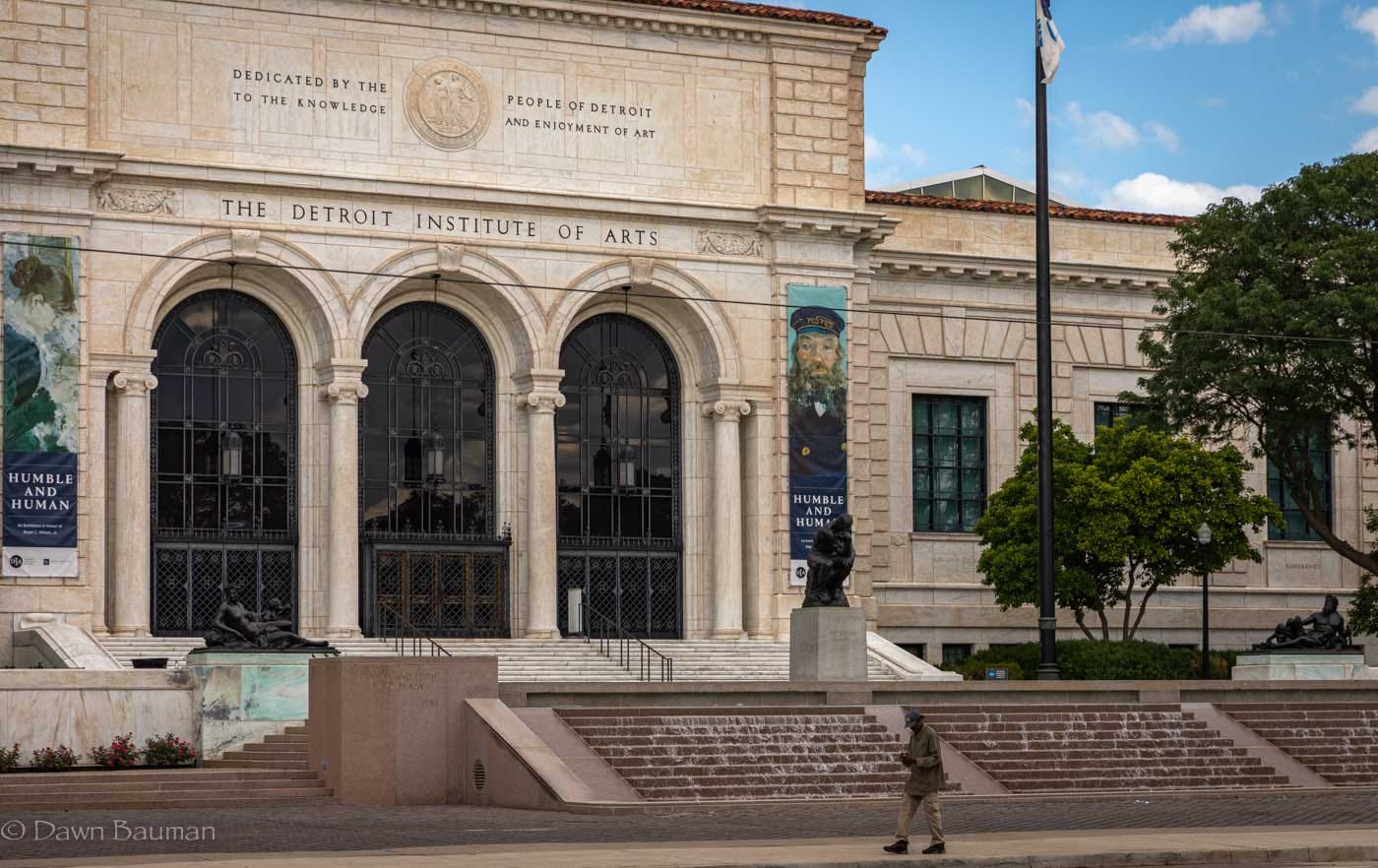
What practise y'all exercise when your city owns a world-class art museum — and the urban center goes abdomen upwardly?
Sell off priceless paintings and artifacts to settle your debts?
Many Michiganders feared only that when Detroit filed bankruptcy in 2013, and then contracted with Sotheby's to appraise the Detroit Institute of Arts' (DIA) collection.
Fortunately the metropolis wasn't immune to pillage its art coffers and the DIA is stronger than ever.
As ane of the peak six museums in the United States, the DIA houses 1 of the biggest and most diverse fine art collections in the country.
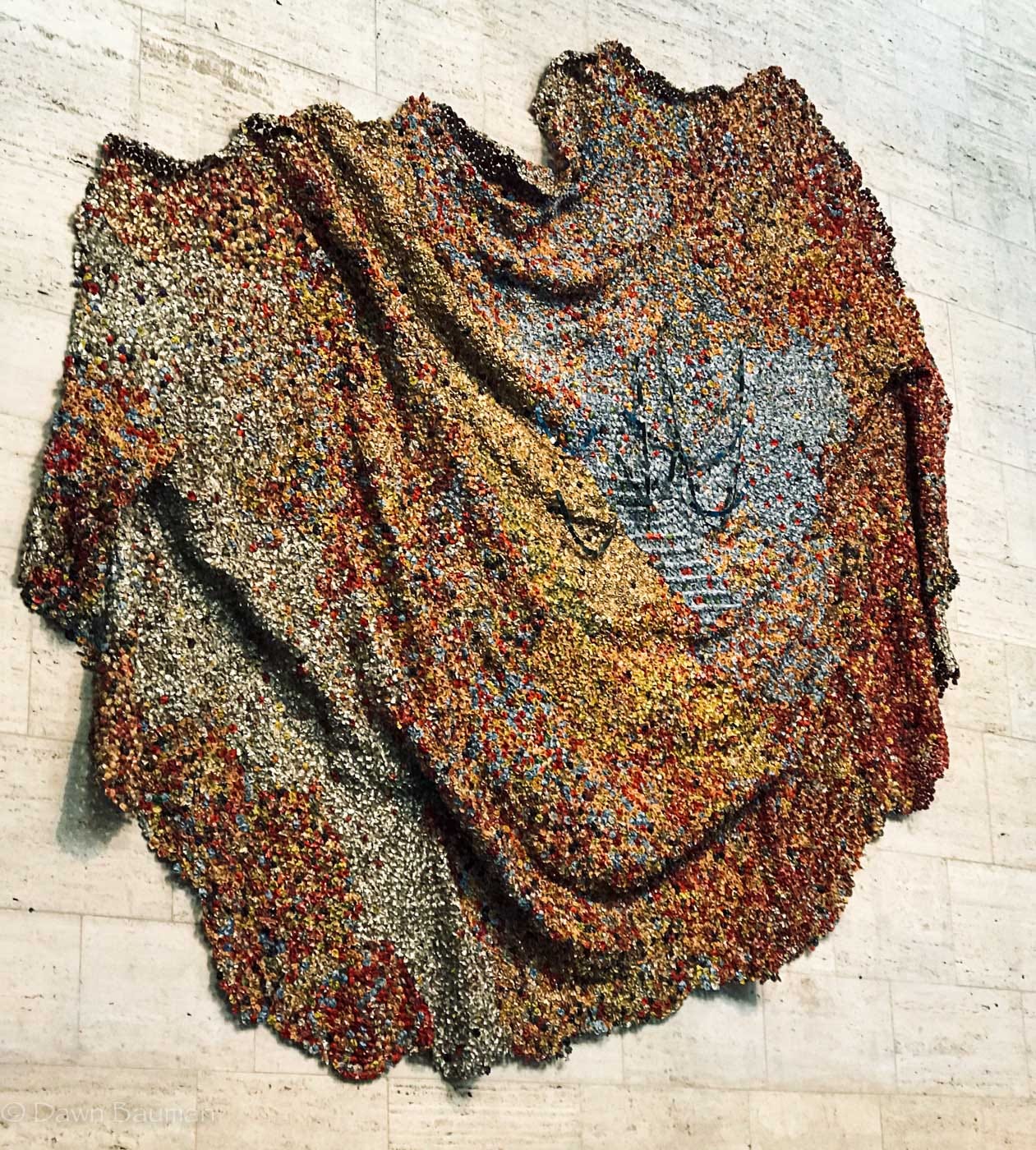
Originally founded in 1885, the DIA speedily outgrew its original location on Jefferson Artery. Later on WWI, the art manager, German emigrant Wilhelm Valentiner, hired French-built-in architect Paul Cret to blueprint a new building.
In 1927 the DIA moved into its new Beaux-Art style building on Woodward Avenue — where information technology still stands.
The building was and so grand at the time, people quickly referred to it equally "The Temple of Art."
What makes this museum special?
Vincent van Gogh's Cocky-Portrait, the outset van Gogh painting to become part of a United states collection, and The Congo'south masterpiece sculpture Nail Figure are but ii of the 65,000 pieces in the DIA's collection.

A rare "Third Phase" Principal's blanket the DIA recently acquired. Discovered during an Antiques Roadshow end in Tucson, the owner had no idea the blanket his grandma used to throw over him while he was sleeping, the blanket he inherited and kept hanging over a chair for years, was literally worth a million bucks.
The garden courtyard where y'all tin marvel at Diego Rivera'southward bigger-than-life full-wall murals. The 27 fresco panels are Diego's interpretation of Detroit and the major industrial complex it had become by the early 1920's.
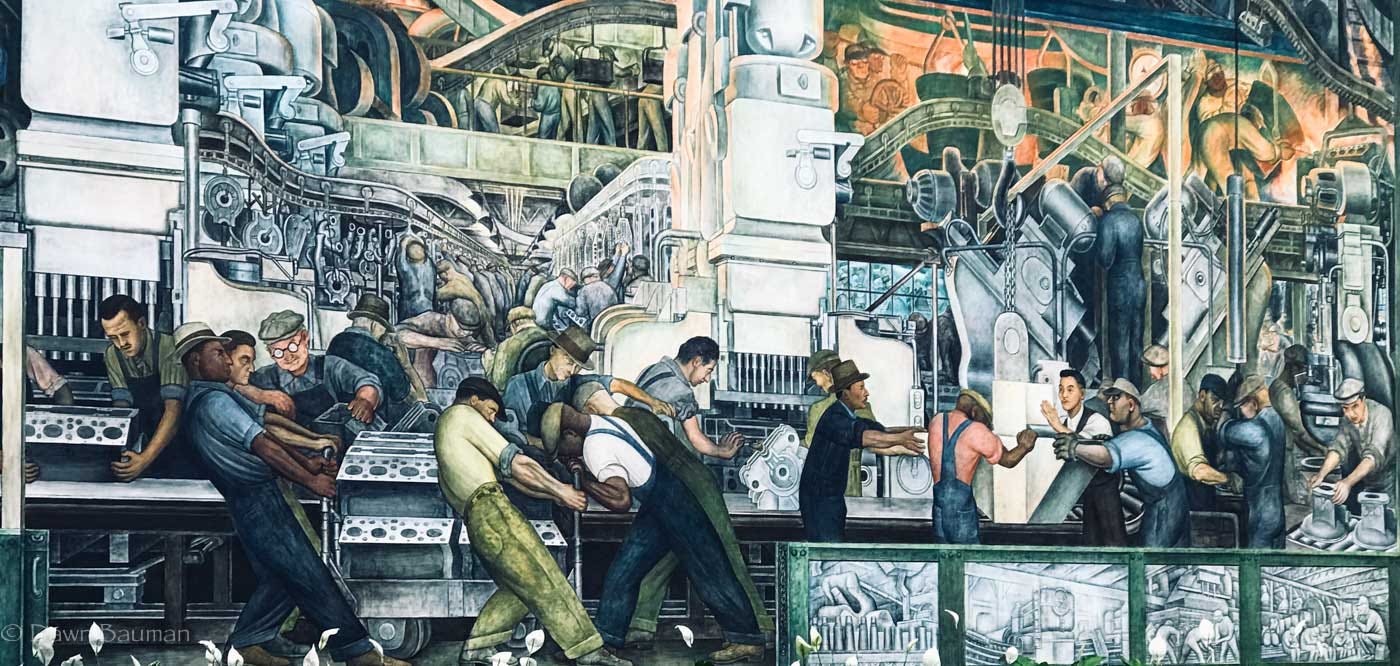
Diego, reportedly, idea Detroit Industry was his most successful work.
To others, information technology was controversial and ugly. Clergymen actually called for parts of the landscape to be destroyed.
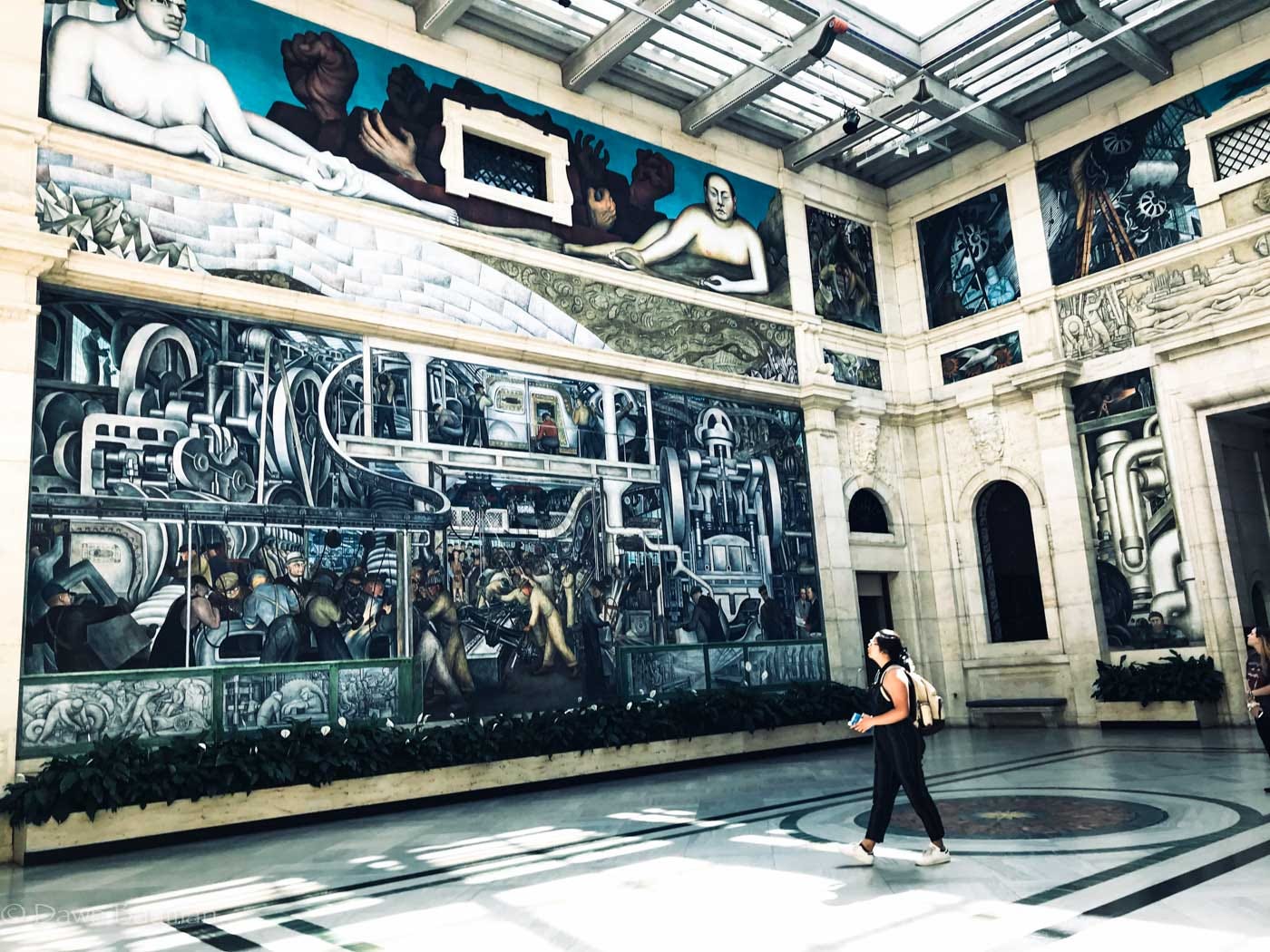
Luckily, Edsel B. Ford (a major funder of the project) and Mr. Valentiner saw value in his work and refused.
Speaking of the irreverant Diego Rivera, if you're really lucky, you might even see Peter Stackpole'due south 1913 film of Diego sculpting "Greta Garbo" out of a turkey os.
Detroit shares knowledge and fine art.
The inscription above the DIA'southward grand Woodward Avenue entrance reads:
"Defended by the People of Detroit to the Noesis and Enjoyment of Art."
With its world-class exhibits, its customs outreach programs, and its many free events, the DIA takes that to heart.
How big is the Detroit Institute of Arts?
For some reason, people ofttimes want to know how big is the DIA?
Afterward 2 wings were added in the 1960s and 70s, and a major renovation completed in 1999, the museum covers 658,000 square feet.
Information technology boasts 100 galleries, a 1150-seat auditorium, a 380-seat lecture/recital hall, an art reference library, and a country-of-the-art conservation laboratory.
And, aye, the DIA has a restaurant — 2, in fact — as well as a large souvenir store.
How much does it toll to go to the Detroit Institute of Arts?
$14 for adults, $ix for senior citizens, $viii for college students, $6 for immature people aged 6–17. Be sure to ask almost discounts. I received l% off the adult ticket with their Baronial AAA discount special.
If you alive in Wayne, Oakland, or Macomb county, you arrive FREE — function of a deal struck after passing a special tri-county millage in 2012.
Where exercise you park for the Detroit Institute of Arts?
There is a well-lit, secure parking lot just east of the DIA (on John R Street). Daily parking is $7.
Tin can you accept pictures at the Detroit Found of Arts?
Personal cameras/aboveboard photography are allowed except when indicated on specific art pieces or exhibits. No flash photography is immune in the galleries; and no tripods, monopods, or selfie sticks are allowed at all.
Detroit'due south Motown Museum — Where Dreams Do Come True
What practise you do when you're a young black man in Detroit working on an assembly line — and all you desire to do is brand music?
If yous're Berry Gordy, Jr., you borrow $800 from the "family bank," purchase a house — and you build a recording studio.
Hitsville USA opened in 1959 — and Motown was born.
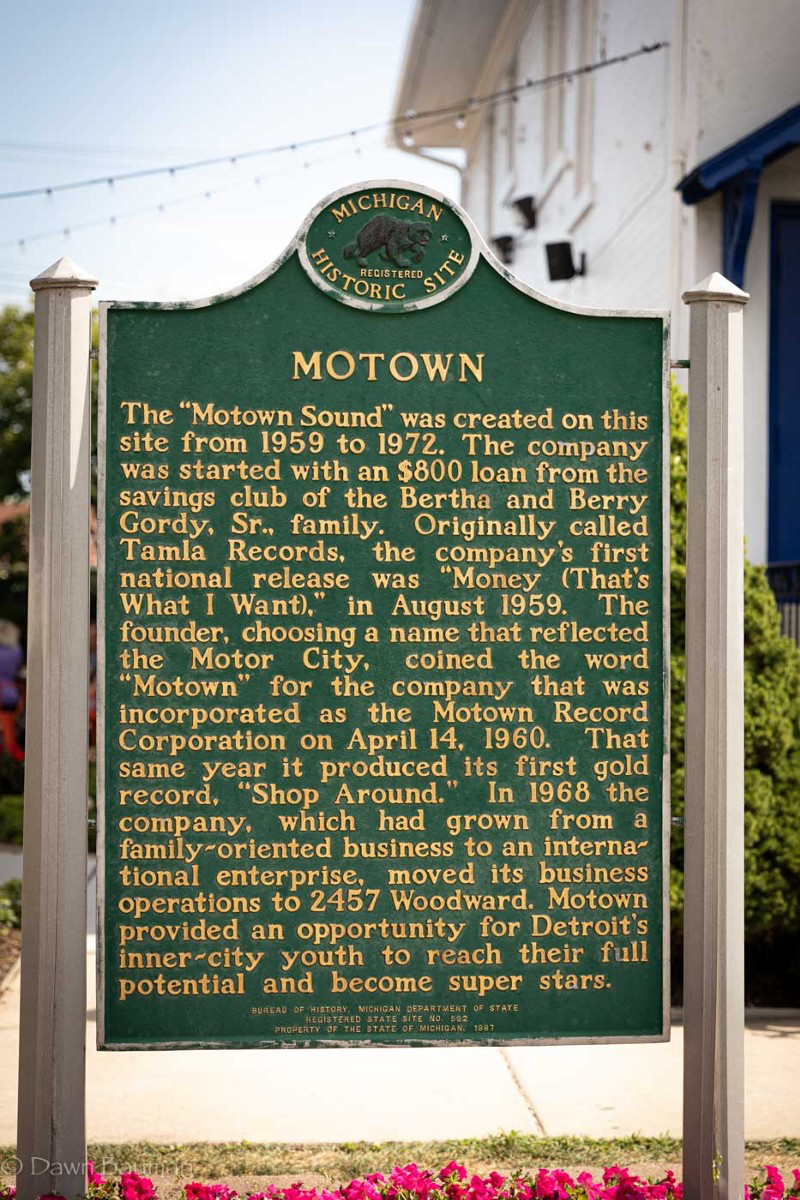
Drupe scouted for local talent — Aretha Franklin, Martha Reeves & The Vandellas, Marvin Gaye, Stevie Wonder, Diana Ross and the Supremes, the Jackson Five, Smokey Robinson and the Miracles, Gladys Knight and the Pips, The Temptations, The Four Tops — and transformed them into stars.
With daring ideas, drive, and determination, Berry'south original $800 loan was a $20 million operation — in just 3 years.
He hired The Funk Brothers to provide background music for all his stars.
He hired Maxine to teach his young talent how to mix with loftier society. When Diana Ross and the Supremes met the Queen Mother during a European tour, they knew just what to exercise.
He hired Cholly to teach his singers how to movement. The Temptation'due south side-to-side finger-snapping trip the light fantastic toe routine — that was Cholly.
What makes this museum special?
During a one hour docent-guided tour, you'll see iconic photos and music memorabilia.
Photos of the early days — before the immature singers became stars. And of the later years — subsequently they discovered "bling."
And memorabilia like Michael Jackson's black fedora and white glove. Yous know, the "Bad" ones.
You'll learn fun facts like…
Marvin Gaye was a drummer in the business firm band before his singing talent was "discovered."
Diana Ross was only 17 when she and her friends went to come across Berry Gordy to audition. Berry told them, as he'd tell all the kids, "come back when you lot're done with school." Diana cheekily shot back, "Schoolhouse is washed at 3:00, we'll see you at three:30." And they did.
Drupe learned that eleven-year erstwhile Stevie Wonder liked Baby Ruth confined. Berry made sure the vending machine always had Baby Ruths placed in the 4th spot from the correct and then blind Stevie would e'er get what he wanted.
You might even hear how once, when the tour ended in the recording studio, a man in the grouping asked to play the thousand piano. And the staff humored him.
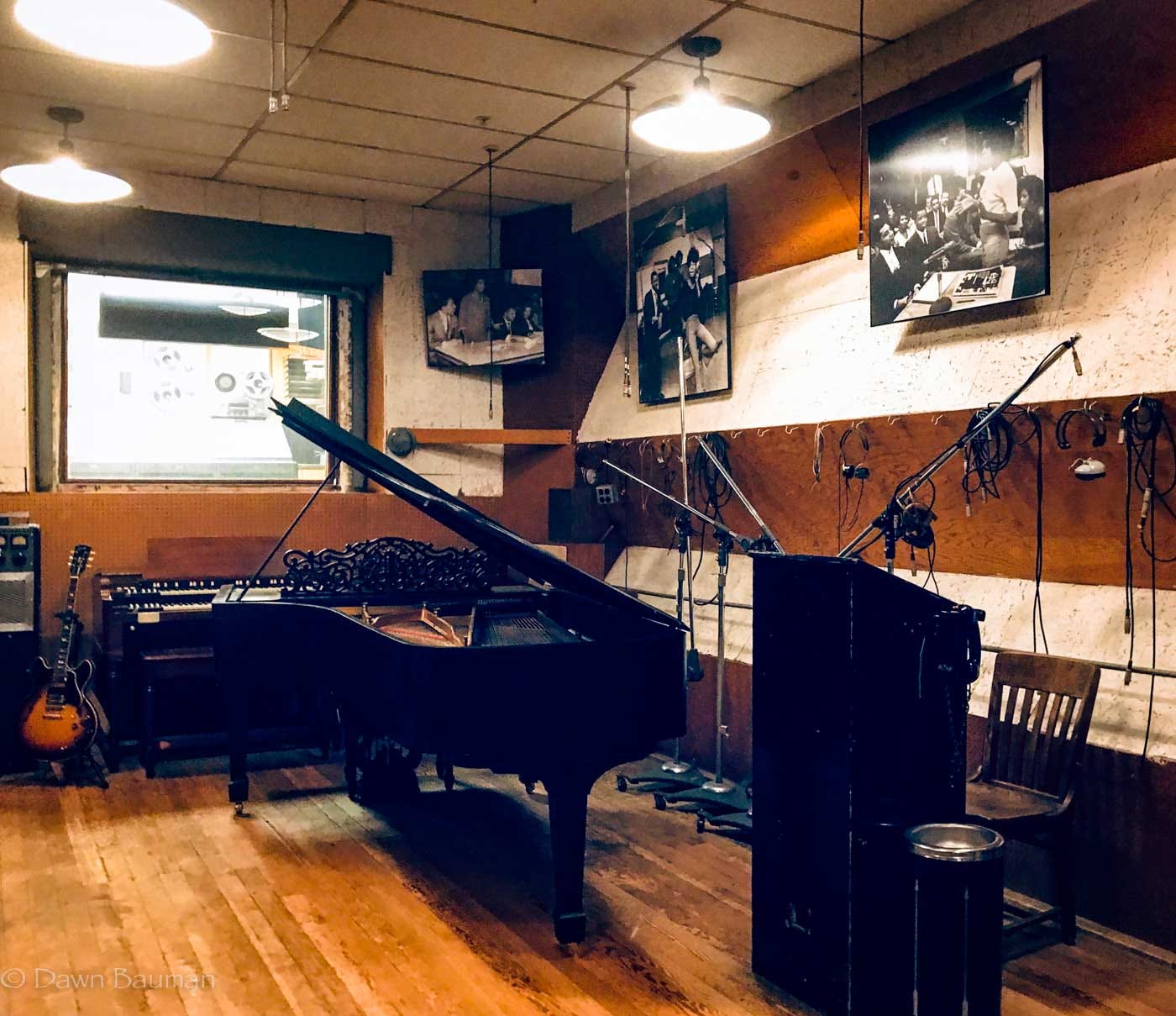
The pianoforte was so out of tune, the guy asked if he could have it refurbished. Drupe Gordy, who was in his 90's, agreed — stipulating that the outside of the grand pianoforte had to remain original.
After refurbishing, the piano played beautifully.
And the generous donor? None other than Sir Paul McCartney.
(Moral of that story: Always check your young man bout members. Apparently, celebrities bout the museum several times a month.)

You become a chance to walk through the original Hitsville U.s.a. house where many objects still sit, as if nobody bothered to pack them up when Motown moved from Detroit to Los Angeles in 1972.
You'll even come across the vending machine where Stevie Wonder bought his Baby Ruth processed bars.
The recording studio (the only place on the tour you can take photos) has its original forest floors, audio system, and pianoforte — leaving you to imagine what it was similar to be a young black singer in Detroit, trying to make it large.
Detroit's Motown-era ended in 1972. But Motown's big dreams continue. In October 2019, a $50 million Motown Museum expansion project began.
With smart classrooms and music studios, Berry Gordy'due south humble Hitsville The states will be transformed into a 21st century artist circuitous.
And Berry's dream of making music lives on.
How long does it take to tour the Motown Museum?
Well-nigh 45–sixty minutes. Tours start every one-half hour.
How much does information technology cost to become to the Motown Museum?
$15 for adults; $10 for seniors 62+ and immature people 5–17 yrs.
Where practice you park for the Motown Museum?
There is no formal parking lot. Street parking is free.
Can you take pictures at the Motown Museum?
Considering of copyright problems, no photos are permitted until the end of the tour. You can take pictures in the recording studio.
Detroit's Dossin Corking Lakes Museum — Don't Judge A Volume Past Its Cover

When yous're exploring Belle Isle, don't turn down the Dossin Keen Lakes Museum similar I almost did.
Inside this apprehensive appearing building lies a fabled museum that showcases more than than 300 years of Great Lakes history.
The original Maritime Museum opened in a beached commercial sailing schooner named the J.T. Wing in 1949. The wooden schooner became and so dilapidated that the museum closed in 1956.
Four years later, the Dossin brothers — 3 young businessmen who loved speedboat racing — funded a new maritime museum. The 16,000-square-pes Dossin Peachy Lakes Museum opened July 24, 1960 — on the same spot every bit the onetime J.T. Wing schooner.
What makes this museum special?
Outside, you'll find the bow anchor from the doomed S.S. Edmund Fitzgerald.
Inside, y'all footstep correct into the admirer's lounge from the City of Detroit Iii, a luxury "floating hotel."
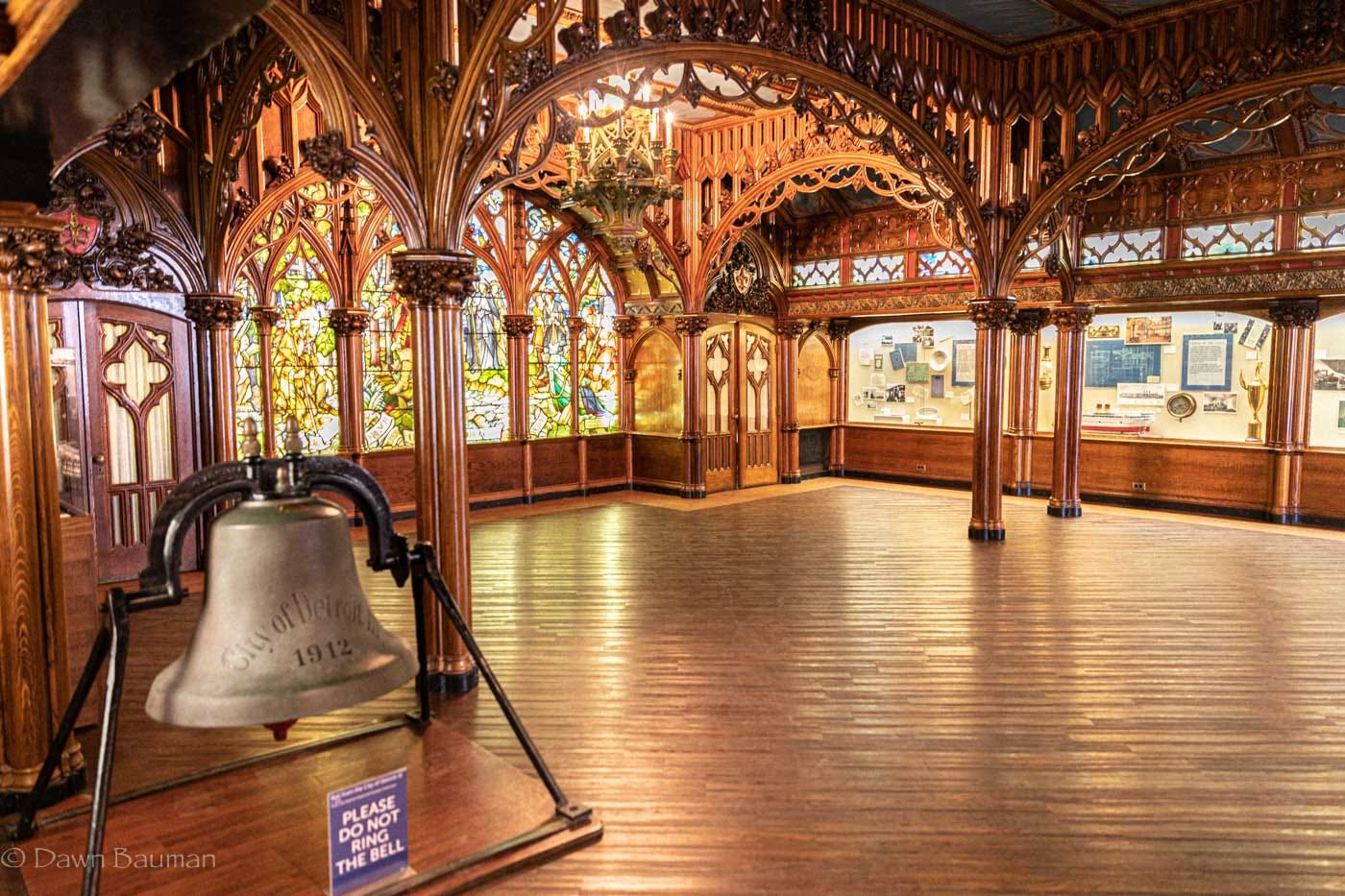
This steel-hulled passenger side-wheeler transported people from Detroit to Buffalo, NY and from Detroit to Cleveland, OH.
If yous were headed to Buffalo, you lot boarded the steamship only before dinner, enjoyed drinks and an elegant repast before settling in for a comfortable snooze. Past the side by side morning, you were in New York.
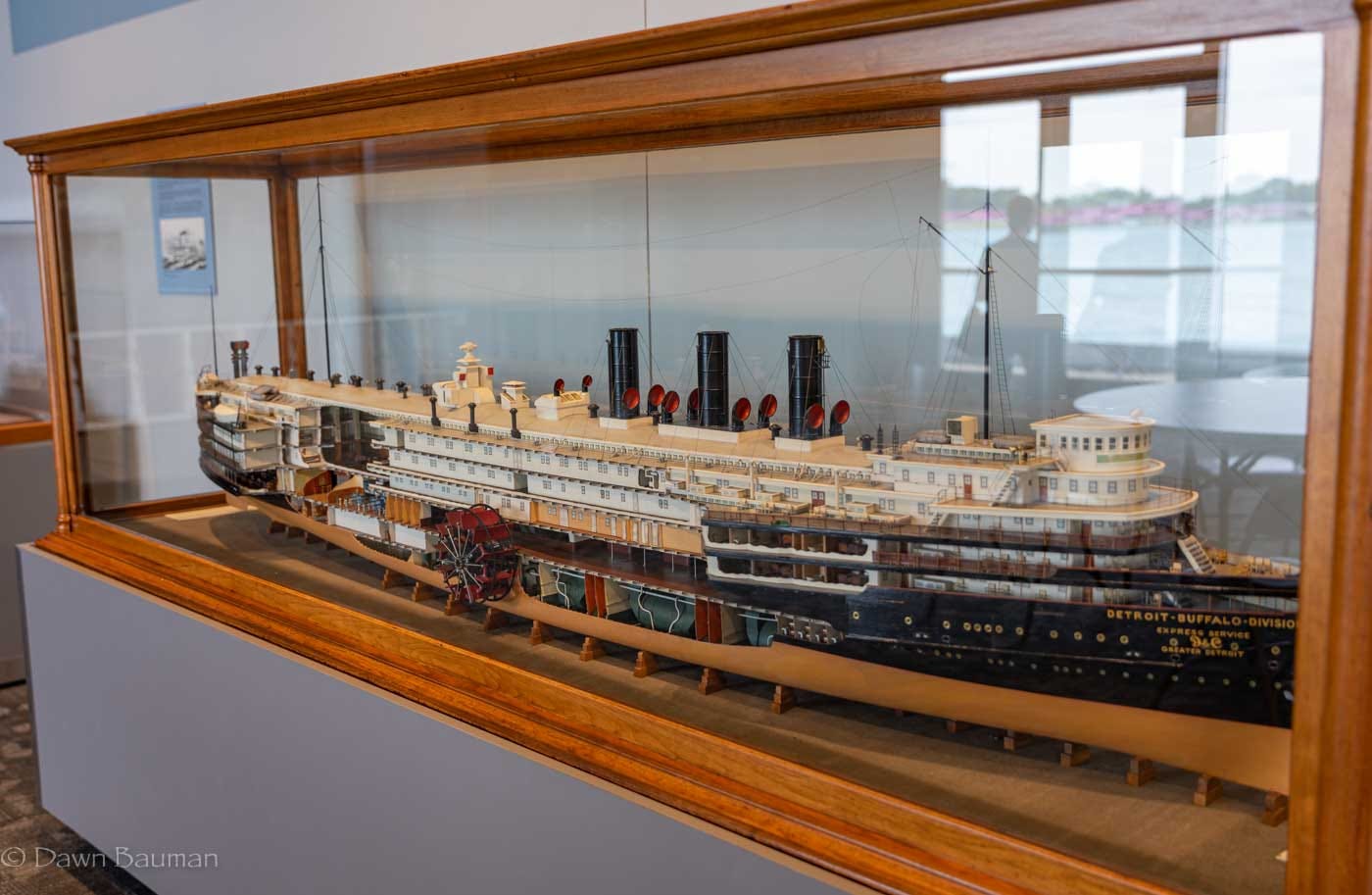
The City of Detroit Three was scrapped in 1956, simply not before the Gothic Room was removed. It somehow ended up in a barn in Ohio where information technology sat for 10 years earlier Detroit maritime lovers raised the funds to buy it back. The restored Gothic Room is now the Dossin Museum's 1-of-a-kind g entranceway.
Discover more than maritime history
From short films to interactive, kid-friendly exhibits, yous larn about the Detroit River and how it helped the metropolis grow into an industrial powerhouse.
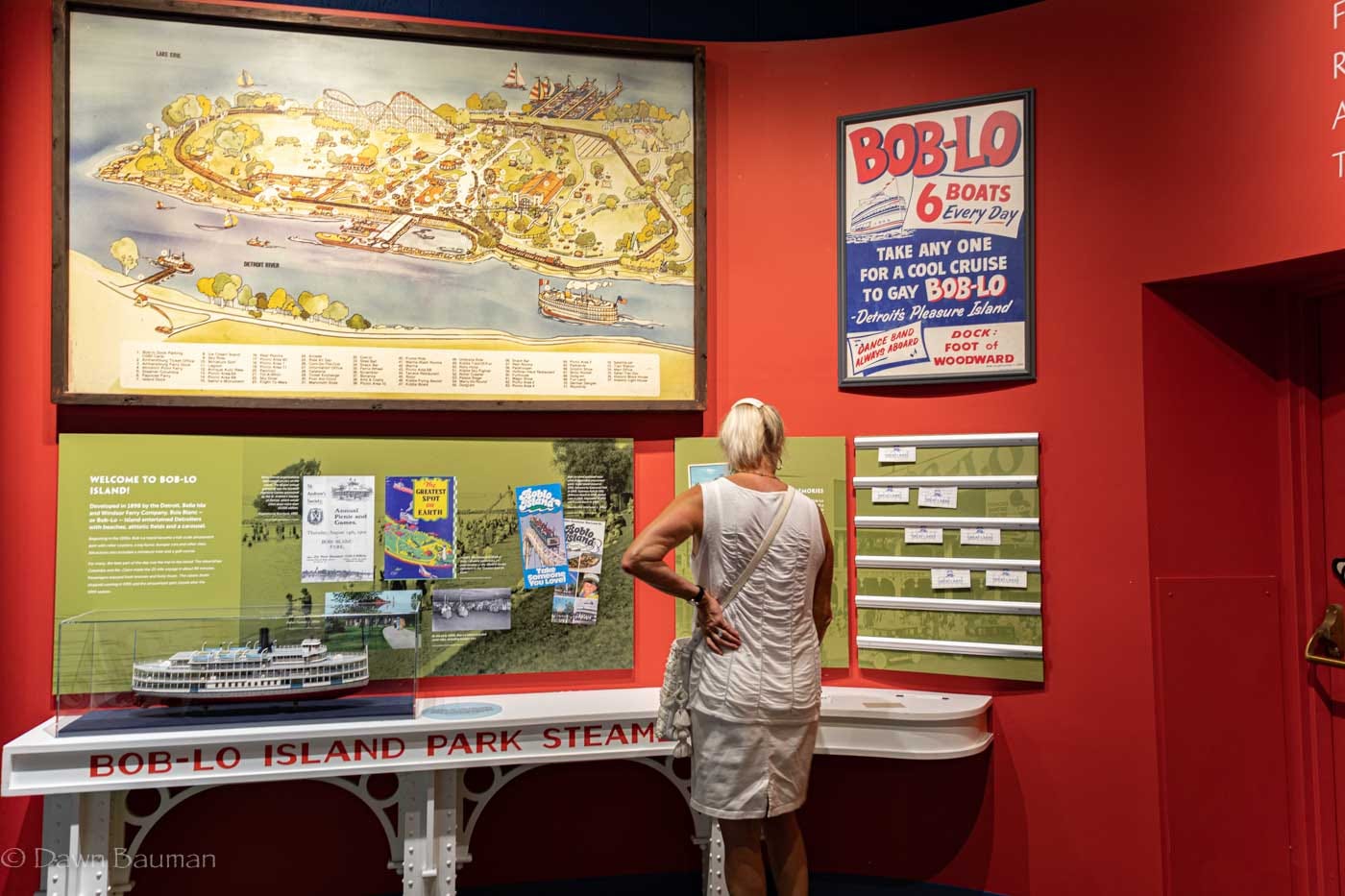
Yous tin can admire the Dossin brothers' championship speedboat, Miss Pepsi — the fastest hydroplane on the Detroit River in the 1940's and 50's.
Yous'll learn how every summer Detroiters cruised to Canada's Bois Blanc Island for a fun-filled day at Bob-Lo Island Amusement Park.
Upstairs, you'll notice the pilot house from the Due south.S. William Clay Ford — a freighter that fell victim to fast-changing technology. Later 34 years on the Great Lakes it became obsolete. And so, in 1987, it was taken apart, the airplane pilot house donated to the museum, and the rest of the send scrapped.
A deplorable end to a send with a brave history.
Simply 12 years earlier, in 1975, when the S.S. Edmund Fitzgerald was caught in a deadly storm, the captain and coiffure of the Due south.S. William Clay Ford left their safe harbor in Whitefish Bay to search for survivors.
Every bit Gordon Lightfoot put it,
"all that remains is the faces and names of the wives and the sons and the daughters."
There were no survivors.
The airplane pilot house has a fun video simulator that lets you try "docking" the Southward.S. William Clay Ford into port. It's harder than y'all remember!
How much does it cost to go to the Dossin Maritime Museum?
The Dossin Maritime Museum is gratis with a Michigan Recreation Passport, which you demand to drive onto Belle Isle. You can buy ane on the island, if needed.
$11 for Michigan registered vehicles. $9 for out of state vehicles (daypass) or $31(annual pass).
Where do you park for the Dossin Maritime Museum?
There is a complimentary parking lot next to the museum. Or yous tin park nearly the Aquarium and Conservancy and walk the short distance to the Dossin Maritime Museum.
Detroit Historical Museum — Where "Memories" Are More than Than Just A Song
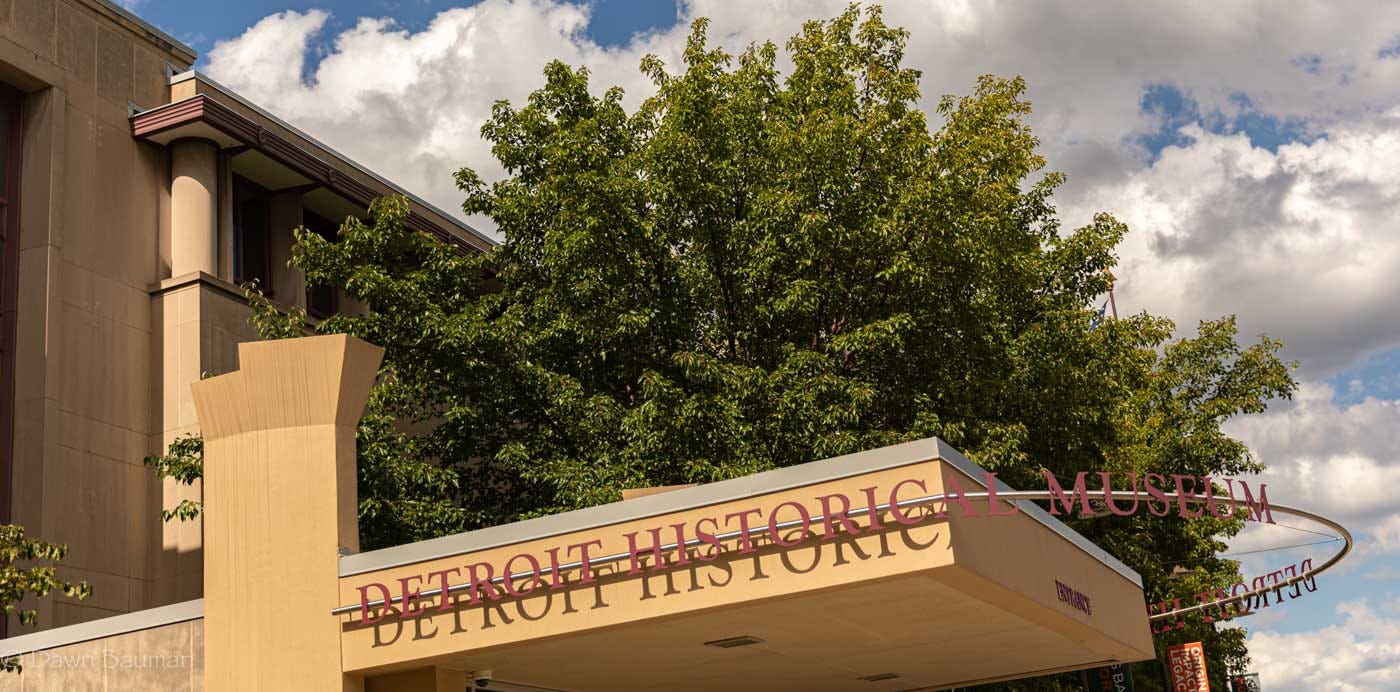
Where can you find an eclectic display of Detroit's 300 twelvemonth history?
From Cadillac'south original French settlement to urban renewal, the Detroit Historical Museum has it all.
This is one of my favorites because it is and so diverse. I could come up back again and over again and however non see it all.
What makes this museum special?
Well-organized permanent exhibits are interspersed with limited-engagement collections, so y'all'll e'er find one-time favorites while discovering new ones.
Where to start…
Before heading indoors, exist certain to check out LEGENDS PLAZA — an outdoor memorial to Detroit-expanse "celebrities" who helped shape the civilisation around Detroit, Michigan, and the United States.
Hither you'll discover cement-bandage handprints and signatures of icons such as Aretha Franklin, Alice Cooper, Joe Dumars, Gordie Howe, Elmore Leonard, Lily Tomlin, Dick Purtan — and many more.
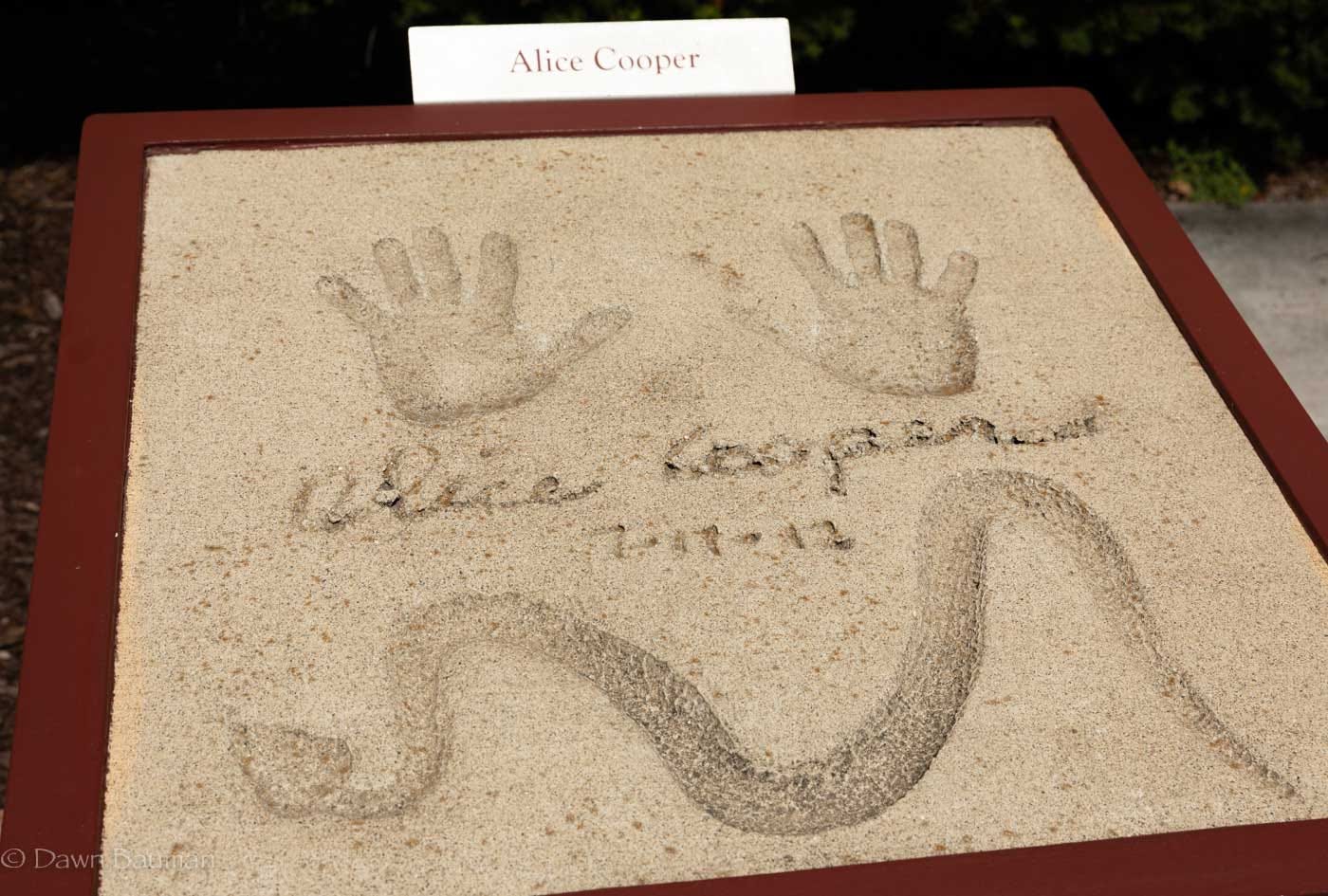
In one case inside, I followed the advice of the docent, and walked downward the short staircase to the lower level. "It's my favorite," she told me.
And I stepped right into LINDELL Ac: AMERICA'S Kickoff SPORTS BAR.
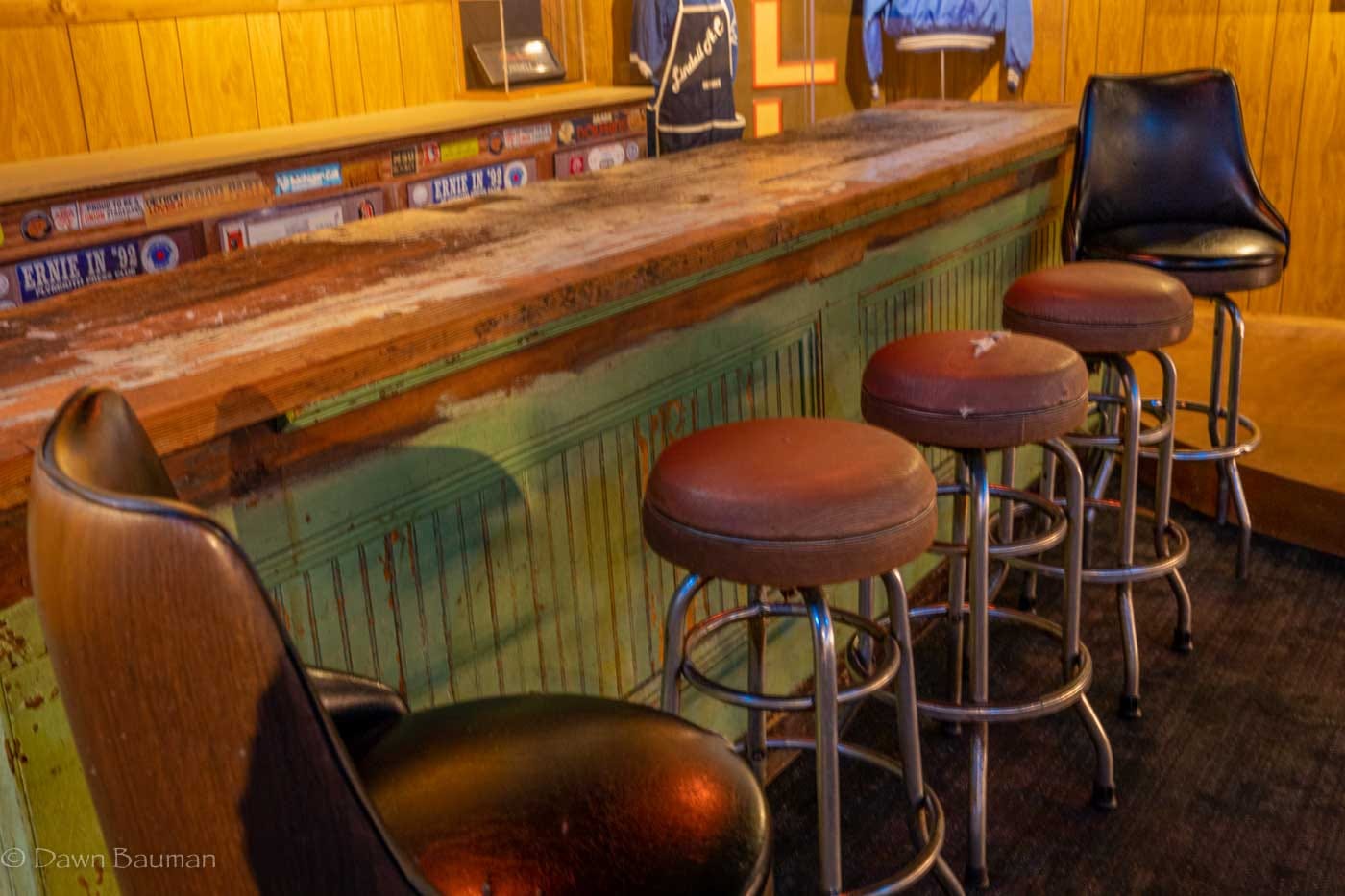
A temporary exhibit, the room replicated the now-closed downtown bar that the Butsicaris brothers and their father opened in 1949.
Later they took the advice of NY Yankee's Billy Martin to hang local sports memorabilia on the walls, the bar became a hangout for athletes and celebrities — likewise equally blue and white-collar workers from nearby businesses.
Micky Curtain. Muhammed Ali. Milton Berle. The list goes on and on.

Like the legendary "Phil's" on White potato Dark-brown, Lindell Air-conditioning was a local watering pigsty with a twist of fascinating characters. And they have the photos, news stories, and sports memorabilia to prove it.
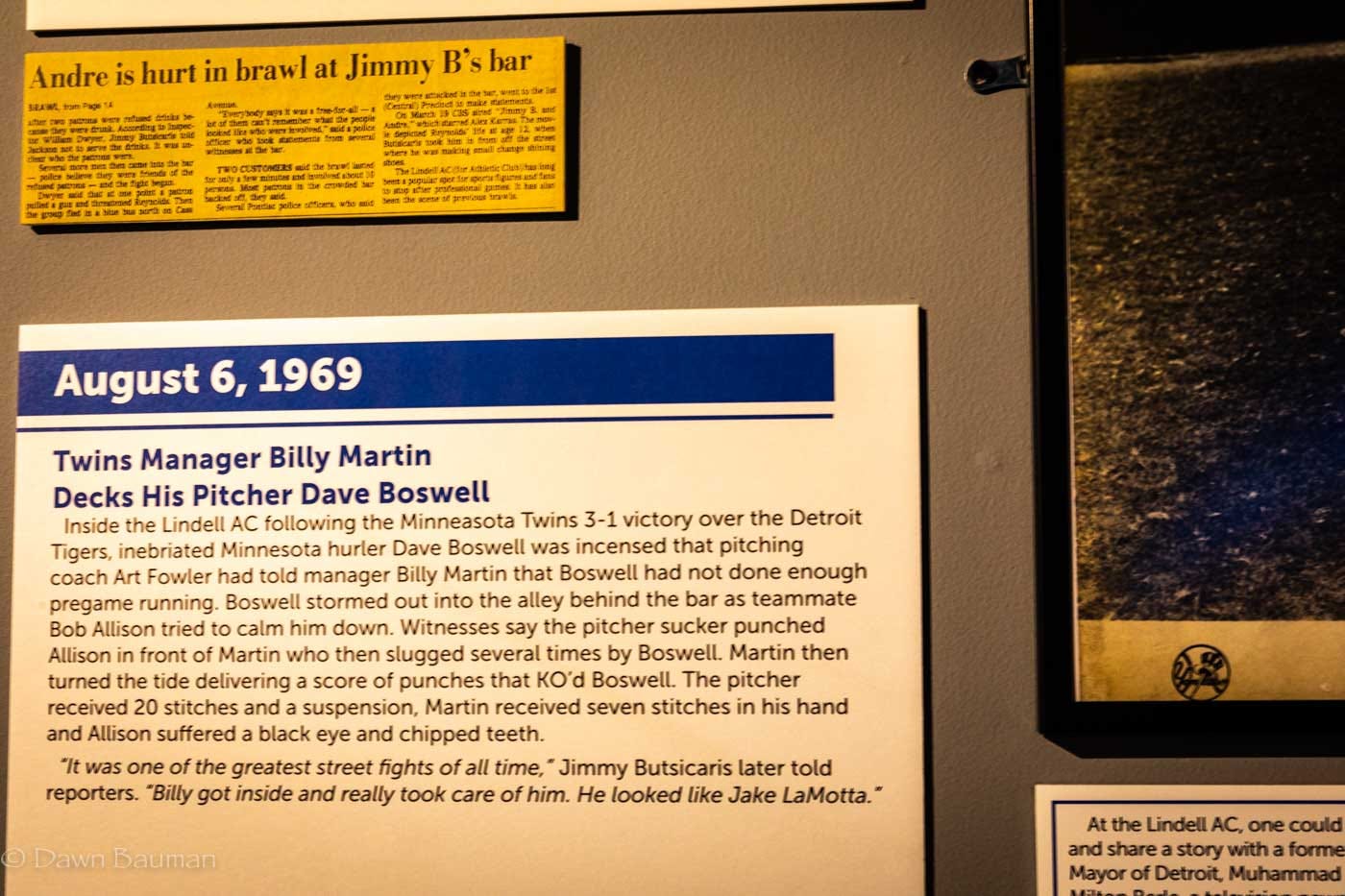
The extensive GLANCY TRAINS exhibit and the interactive STREETS OF Quondam DETROIT round out the lower level.
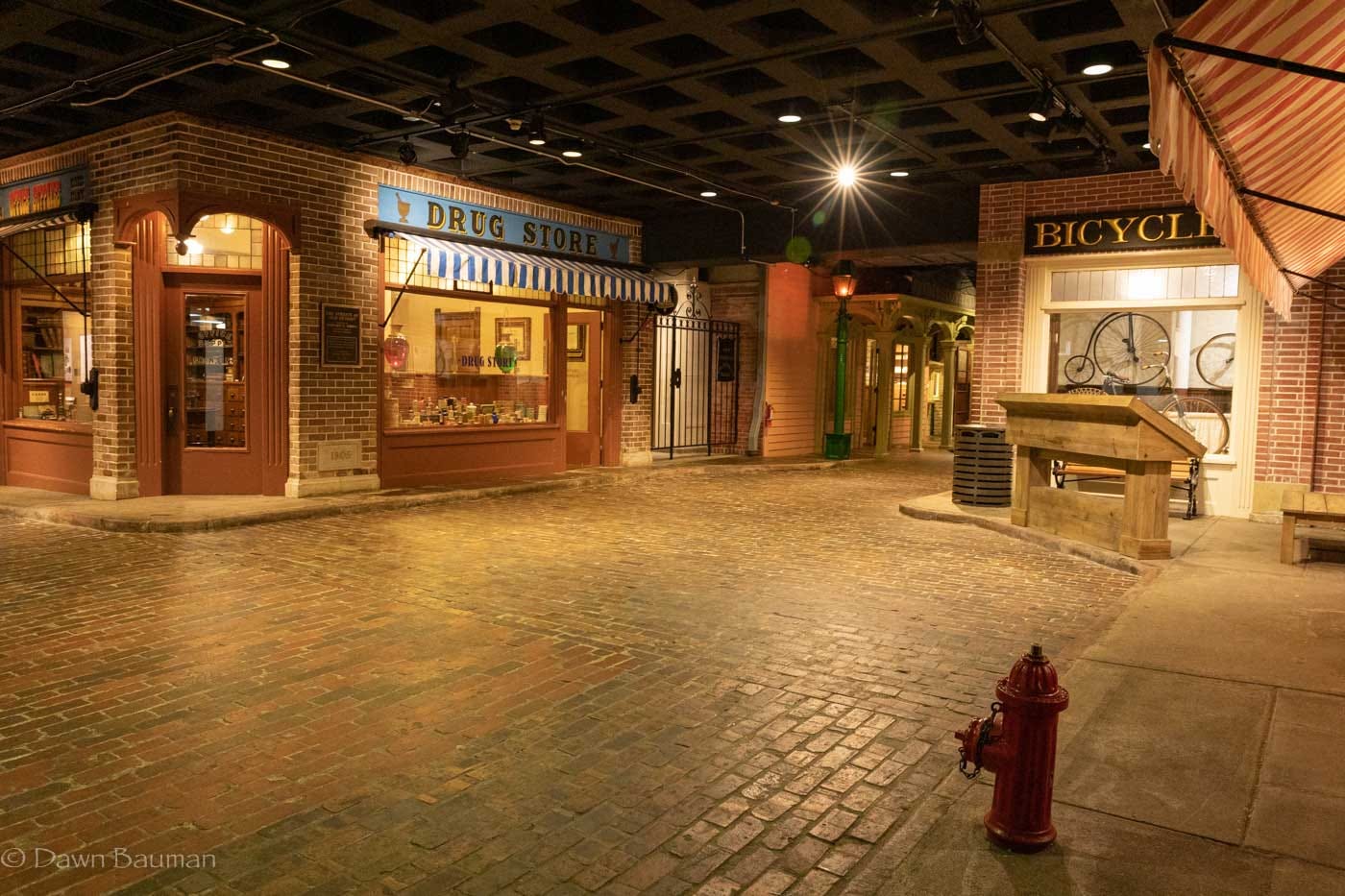
Back upstairs, AMERICA'S MOTOR CITY explains how cars built Detroit and how Detroit congenital cars.
You can spotter the Cadillac "body drop" lower a "Caddie" onto its frame, just similar it did before the Clark Street assembly plant closed in 1987.
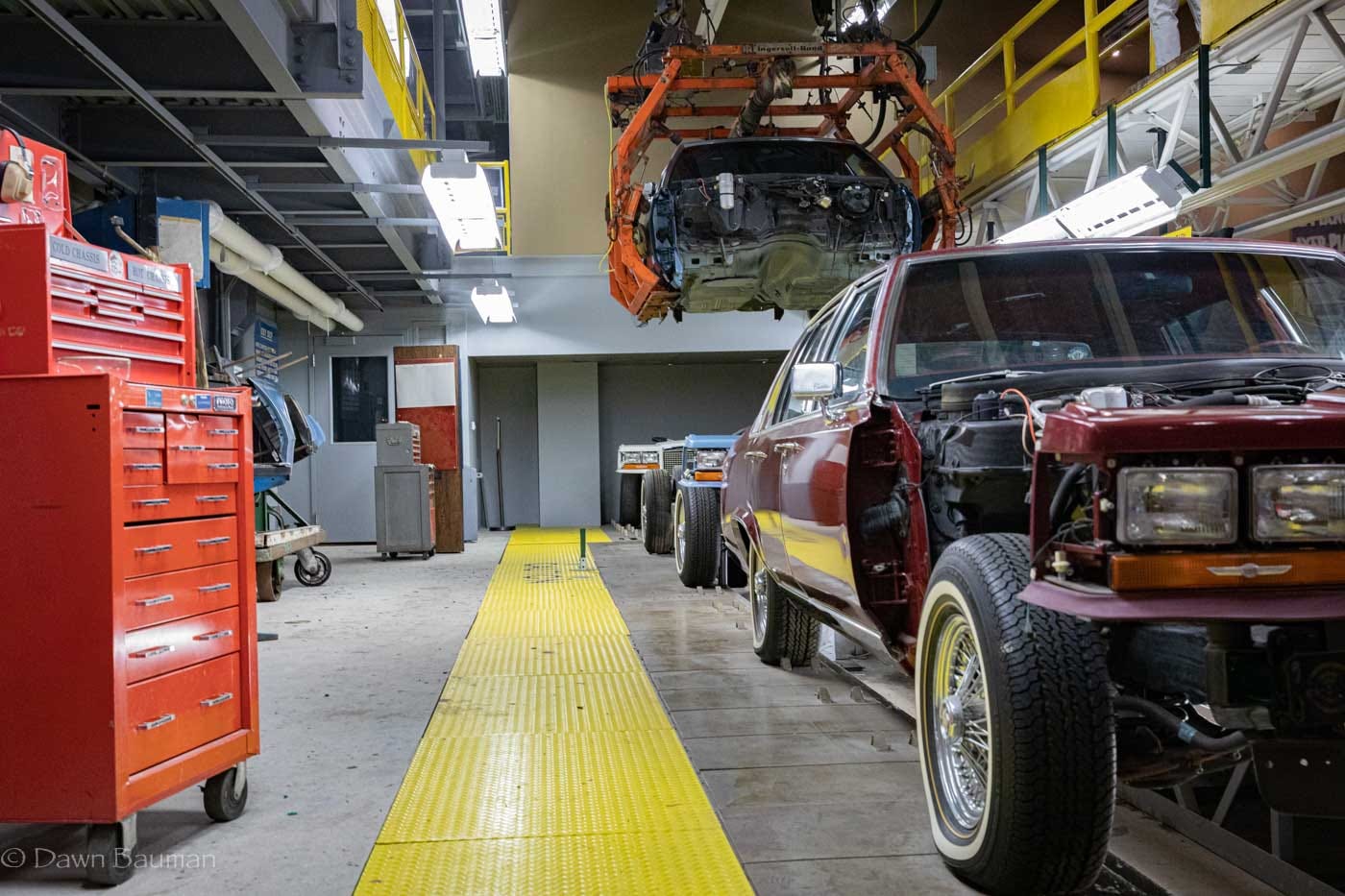
From innovators to movers and shakers, THE GALLERY OF INNOVATION introduces you to the people and resources that made Detroit an industrial powerhouse.
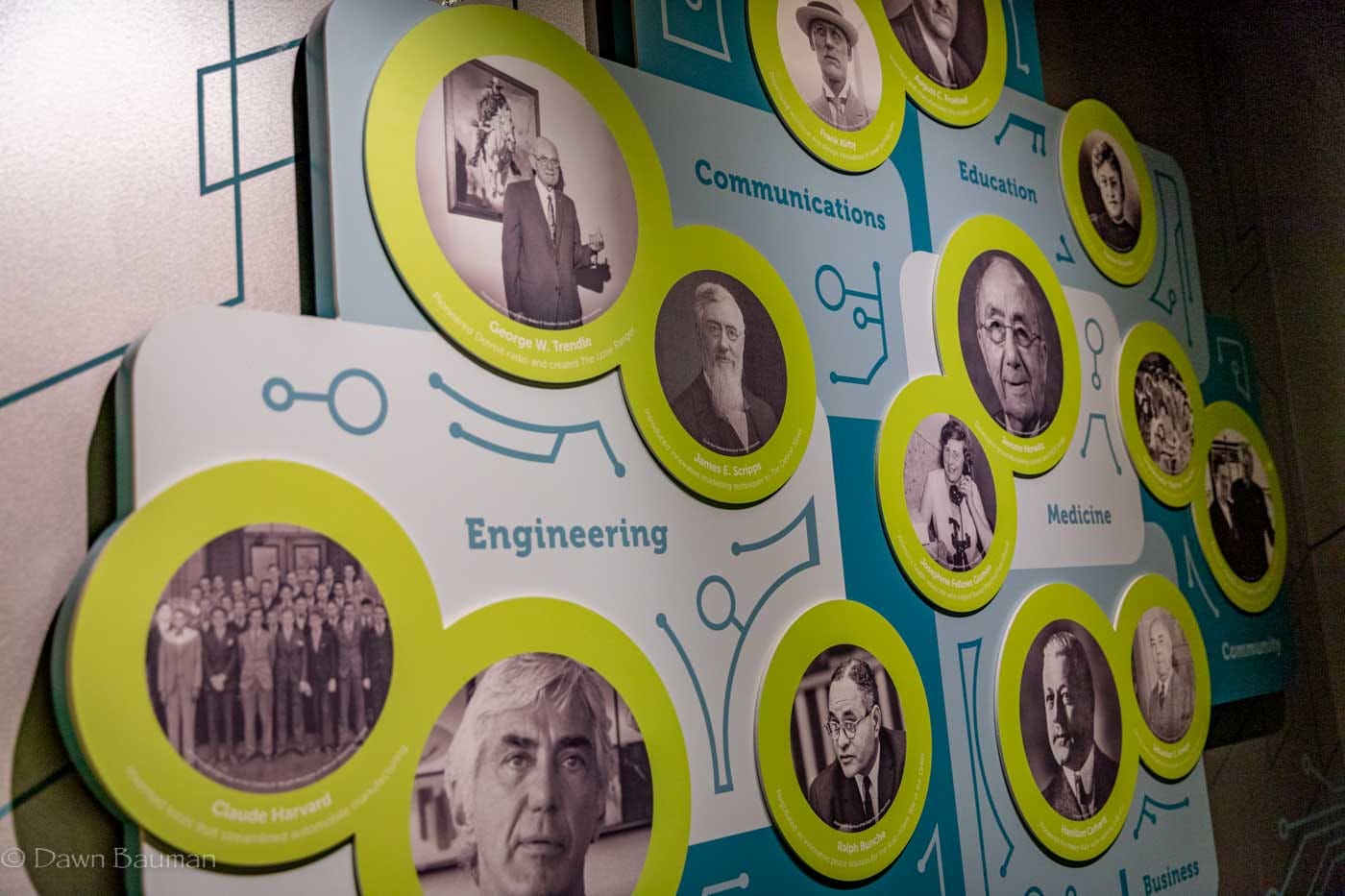
Did you know that, in guild to help the state of war effort, not 1 car was produced in Detroit during WWII?
DETROIT: THE "ARSENAL OF DEMOCRACY" shows what the auto factories were upwards to instead.
From union-busting to "rum-running," from the Hole-and-corner Railroad to the Detroit Bike Men, from Bob Seger to Bob-Lo cruises, they have it all.
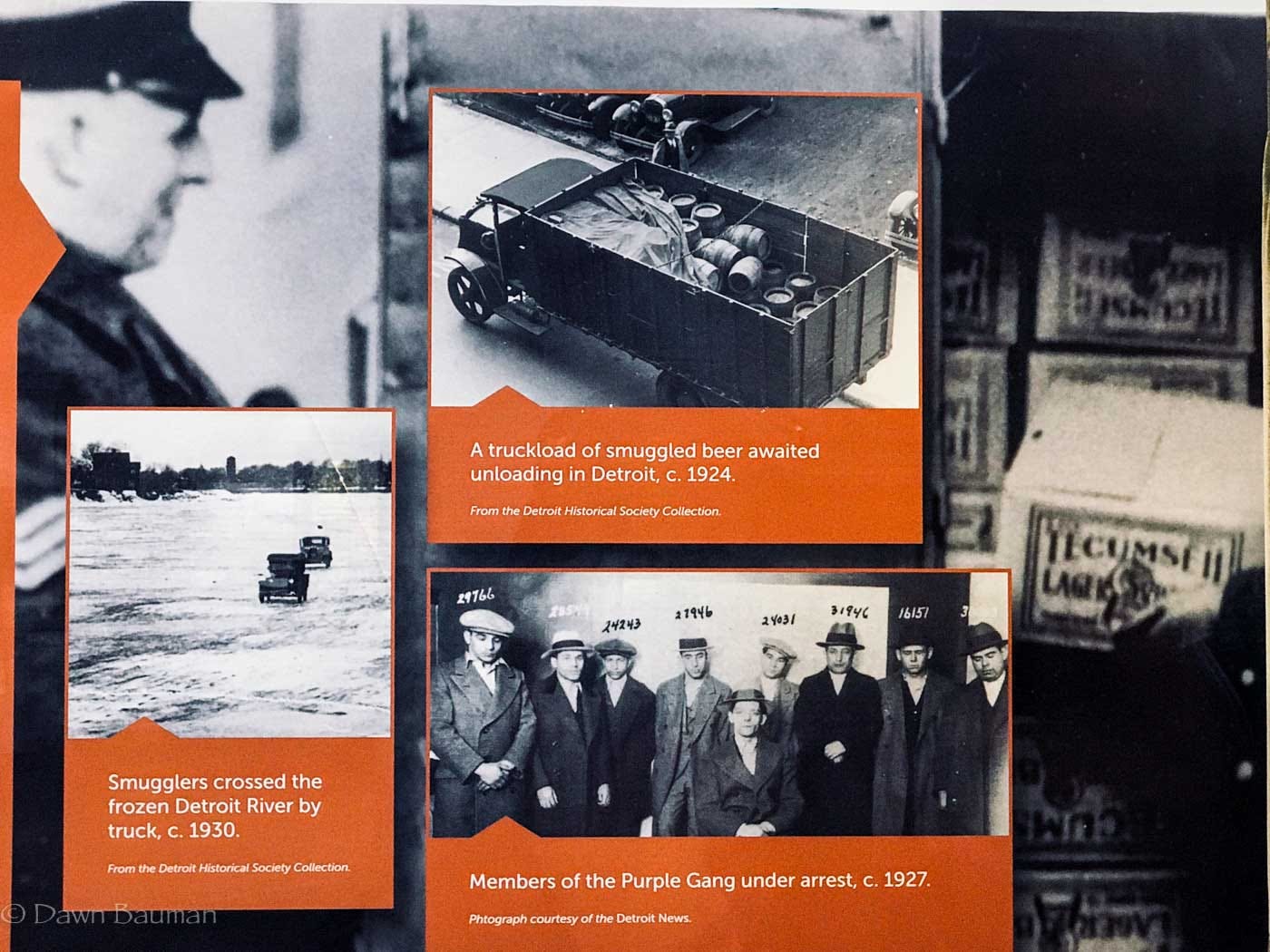
ARETHA, a special tribute to Aretha Franklin, is in the Kid Rock Music Lab. The Queen of Soul grew up in Detroit and always came home to her city.
Be sure to check out the ALLESEE GALLERY OF CULTURE on the Main flooring — especially if y'all grew up in or around Detroit.
Organized into four time periods, the exhibit displays a mishmash of iconic trivia. Yous can't help muttering "I remember that!" equally you meander through.
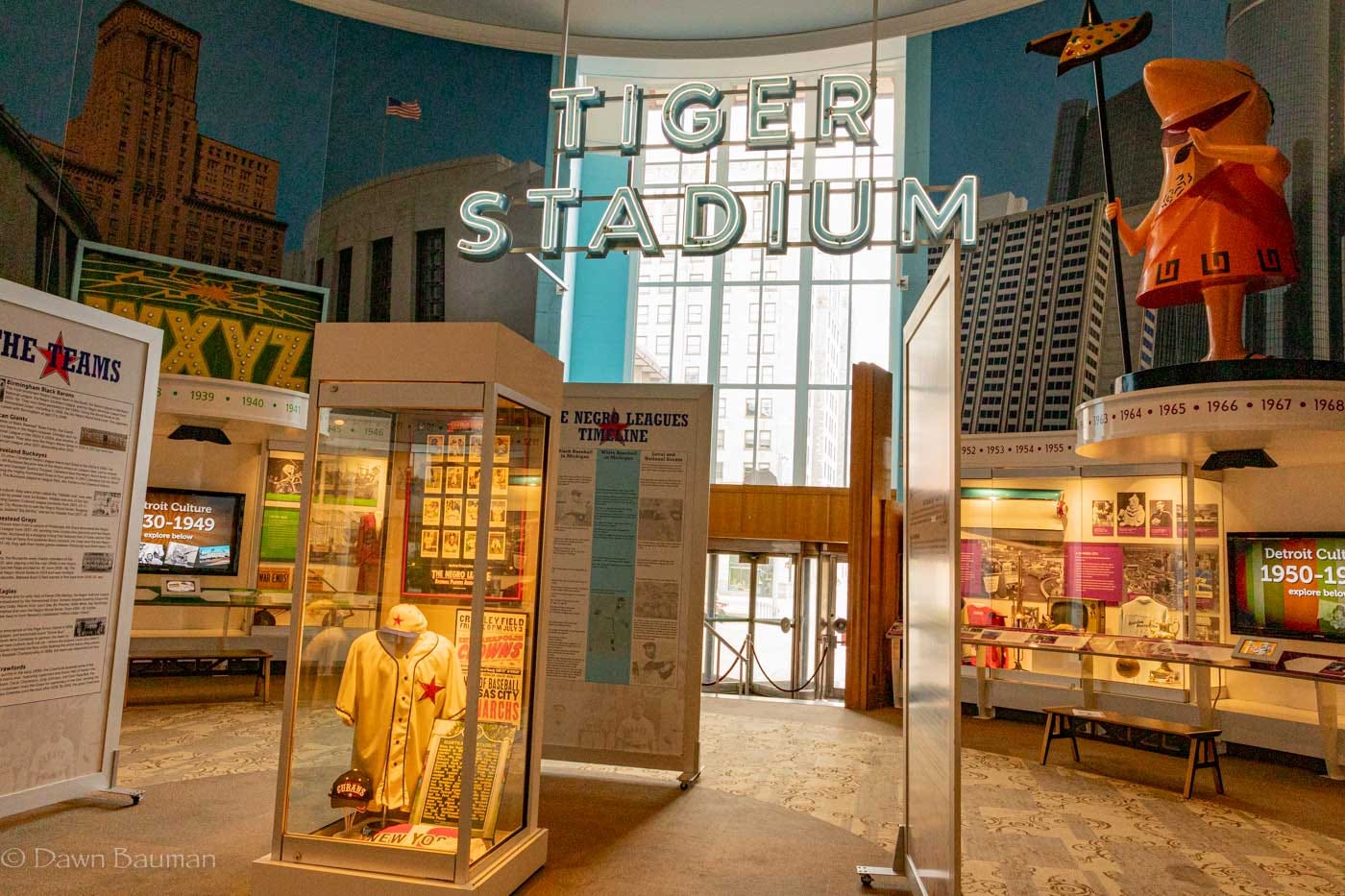
And last, but not least, MEIERS' WONDERFUL CLOCK. Located on the landing between the first and second floors, this original clock was congenital by a jewelry-store owner, Louis Meier, over a 12 year period. It has a master clock and 12 smaller clocks with chimes rung by Father Fourth dimension plus figures representing the 4 stages of human being's life — all running from ane pendulum.
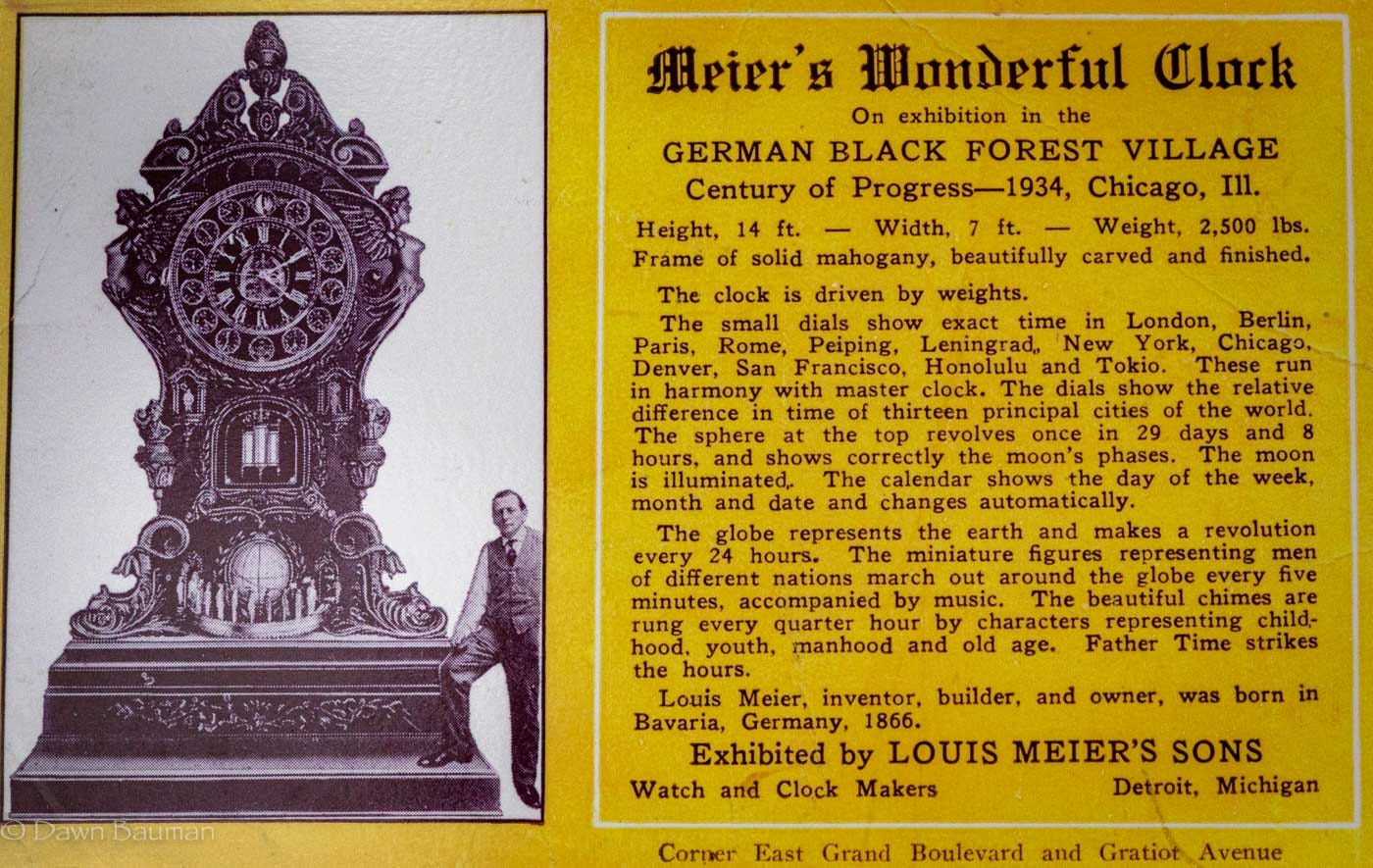
The clock was so original so complex, it was displayed at both the Michigan Country Fair (1906) and the Chicago's World Fair (1934).
Is the Detroit Historical Museum free?
When I went through this summer, access was free (another reason it was a favorite — score!). Only as of November 2019, the Detroit Historical Museum started charging admission again.
$10 for adults; $viii for seniors, students, active military machine and first responders; $6 for young people ages 6–17; For a "household" (upward to half dozen people living at same address), the price is $35.
If you are a Detroit Historical Club fellow member, admission is Complimentary.
With the quality and diverseness of the exhibits, the price of admission is well worth it.
Where exercise yous park for the Detroit Historical Museum?
There is a museum parking lot on Kirby Street (between Woodward and Cass Avenues). Daily rate is $ix.
Again, if you are a Detroit Historical Society fellow member, parking is Costless.
Y'all can also find parking nearby at the Detroit Institute of Arts and Wayne State University.
Detroit's Ford Piquette Avenue Plant Museum — From Failure to Hero in Just six Years
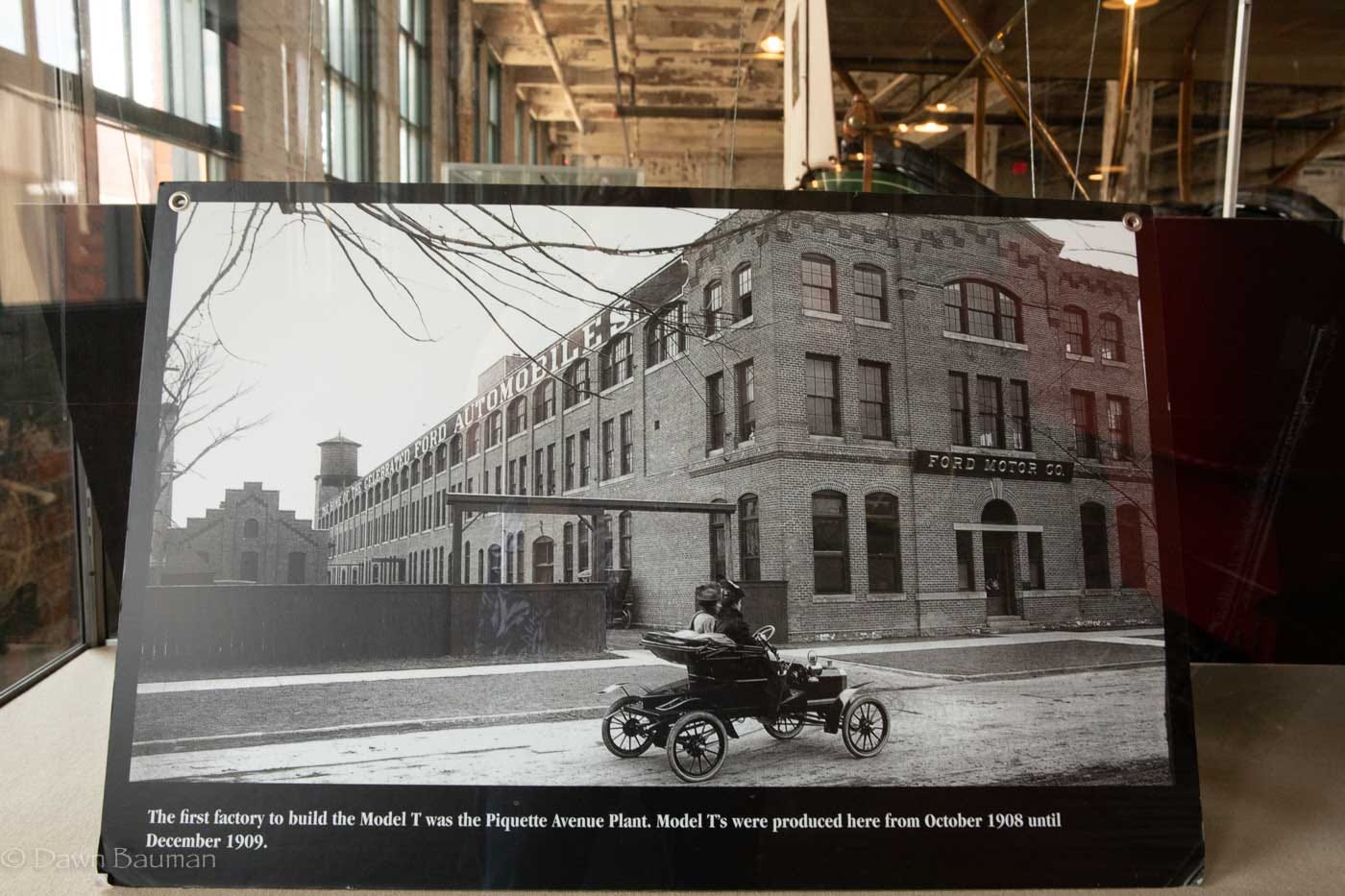
What do you do when you've started 2 car companies — and they both flopped? Well, if you're Henry Ford, you plough to car racing.
And you win.

You win and then often you attract men with money willing to back your third attempt.
Which is why, in 1903 — when Henry was 40 years old — he and several investors founded Ford Motor Company.
And even though Henry didn't throw in any cash, the company carried his name.
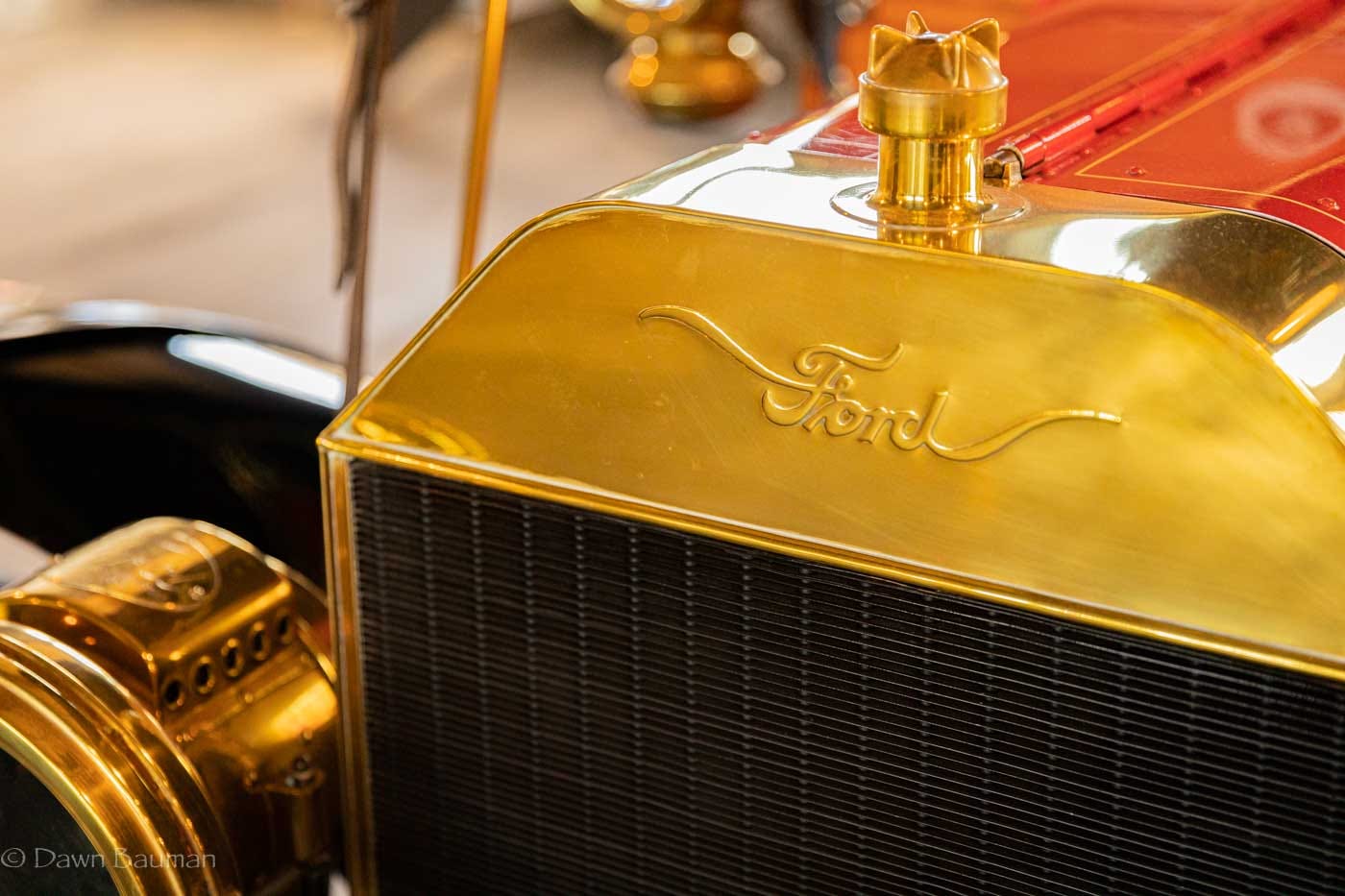
Because Henry was a man of activity.
So he immediately rented a building on Mack Avenue and got to work.
He built his first car, the Model A, which sold so well that, a year later, the new Ford Motor Visitor decided to build their own mill — the Ford Piquette Avenue Establish.
And 6 years afterward, when Henry was 47 years onetime — the age of "average life expectancy" for a human being of his era — he had built one of the about successful auto companies of all fourth dimension.
He had built a automobile for the masses. And he had changed the lives of millions.
What makes this museum special?
Two floors of celebrated (and ofttimes rare) cars, exhibits, and memorabilia combined with an enthusiastic (and oft witty) docent — with great stories.
You can take the tour or wander around on your own. Or, like me, you tin opt to practise both. They don't kick you lot out until 4 pm.
If yous take the tour, you lot'll see and hear stories about …
The 1904 Model B (Series #1) — the rarest motorcar in Ford's history.

Henry produced this model only to appease his major investor, Alexander Malcomson, who wanted to produce luxury cars. That's what all the other motorcar companies were making, and he wanted in on the activeness.
Model B's sold for $2000 each — much as well expensive for most people in the early on 1900s.
Yous'll hear how this particular Model B was discovered in a Missouri barn — in pieces, with a tree growing through its frame. And how a guy bought it, restored it, and discovered he had on his easily the first Model B e'er produced — the one near probable driven by Henry Ford himself.
The 1908 Model G roadster — the car that put Henry on Detroit's radar.
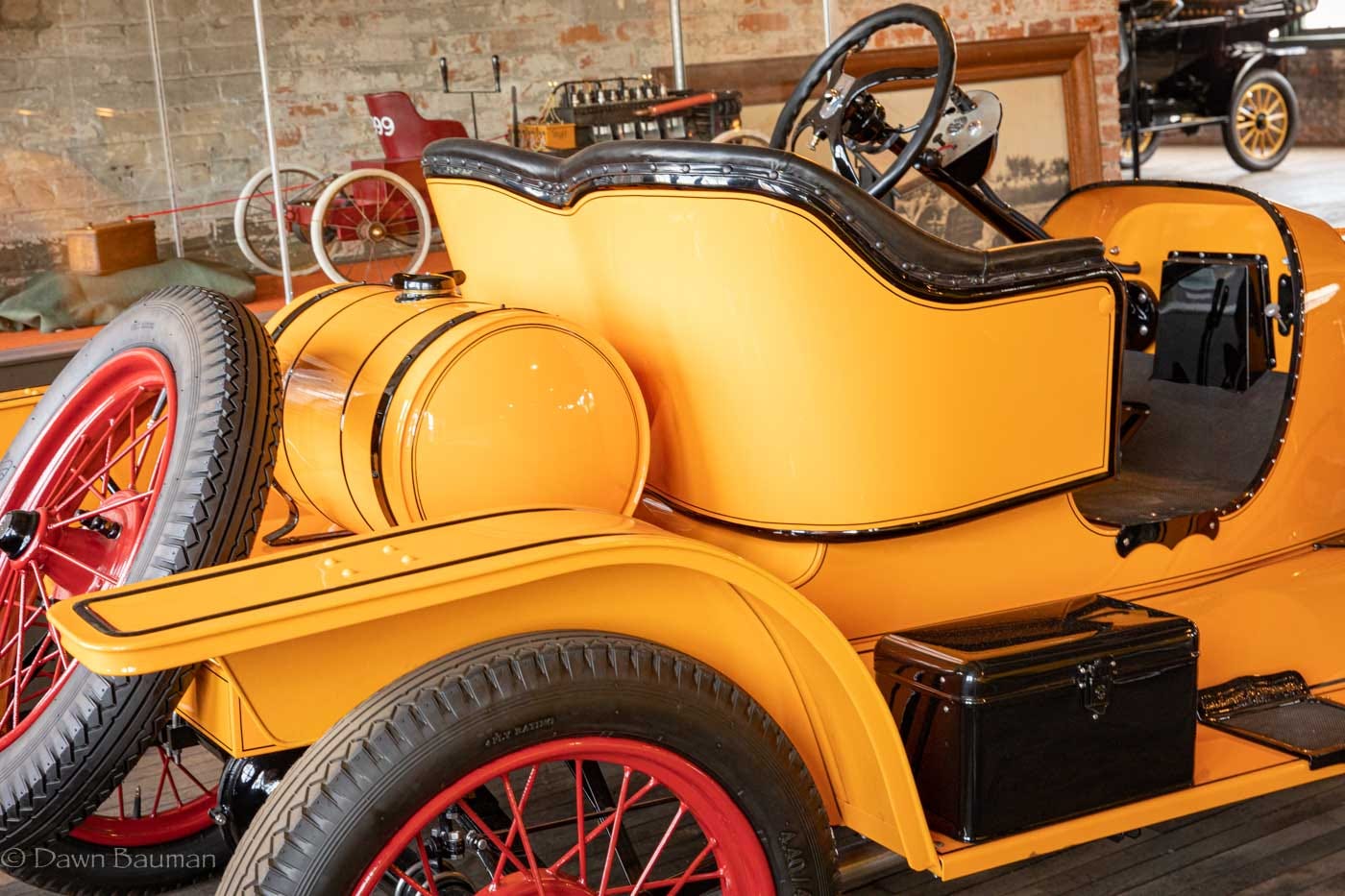
The Model Thousand was a "race auto sold every bit a family automobile." It had a 6-cylinder, 40 HP, 405-cubic inch engine, and could attain a height speed of lx mph.
By breaking speed records, the Model One thousand brought "name recognition" to Ford Motor Visitor.
The Model K cost $3000. Once again, too expensive for most folks.
Out of 965 Model K'south built, merely 28 are left in the world. The Piquette Artery Museum owns one of the 10 remaining roadsters.
The Model North, R & S — marketing, testing, and back to the drawing board.
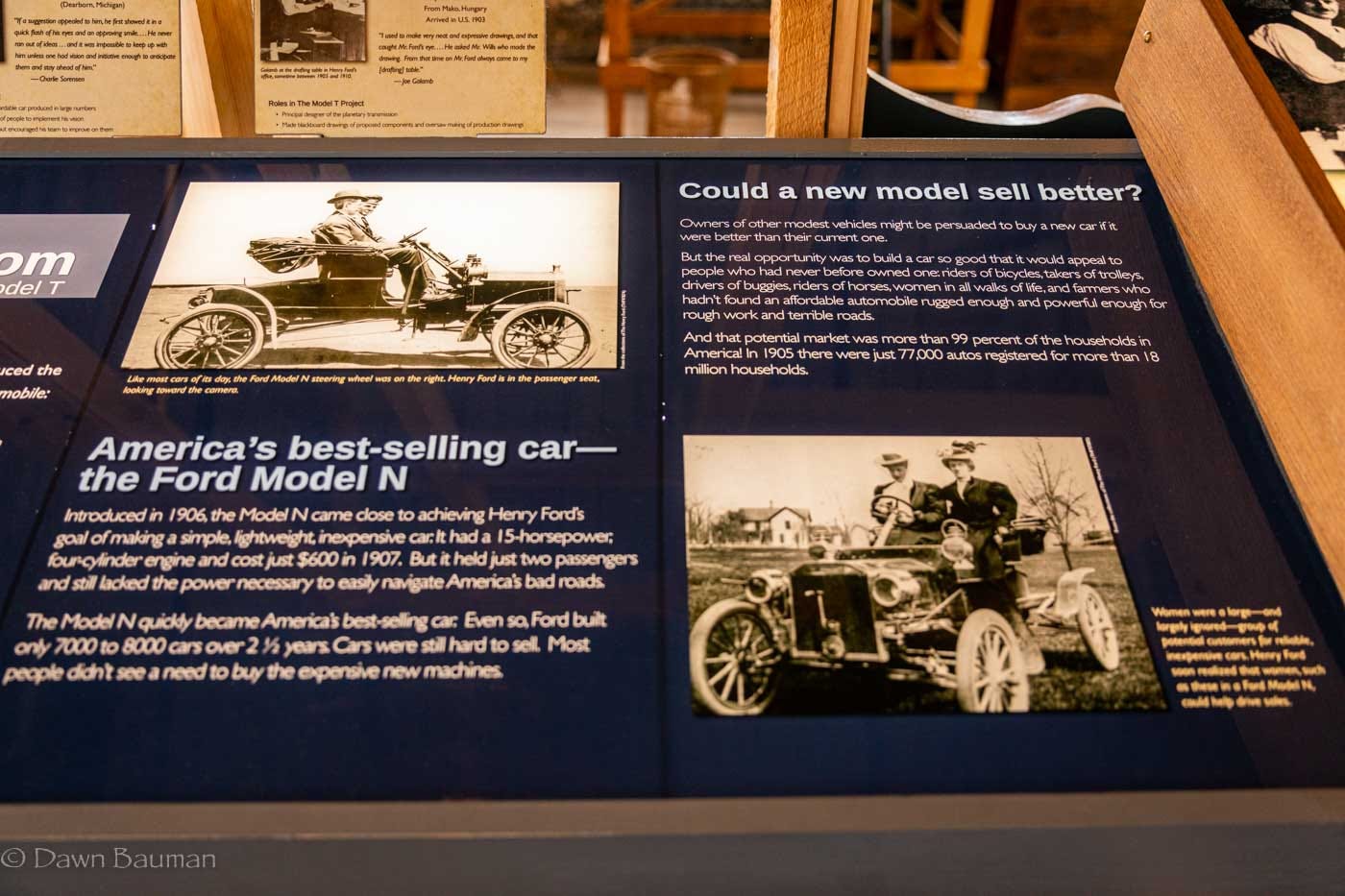
In 1906, Henry bought out Mr. Malcomson, and promptly started working on his dream: an affordable car for everyman.
His outset small-scale car, the Model North, sold for $500. Since competitors' cars were all $1000 or more, Henry'southward car was a hit.
Not satisfied, Henry and his team of designers and engineers tweaked cars (producing Model R & Model Due south) until, finally Henry Ford realized his dream.
The Model T — how Henry became a hero.
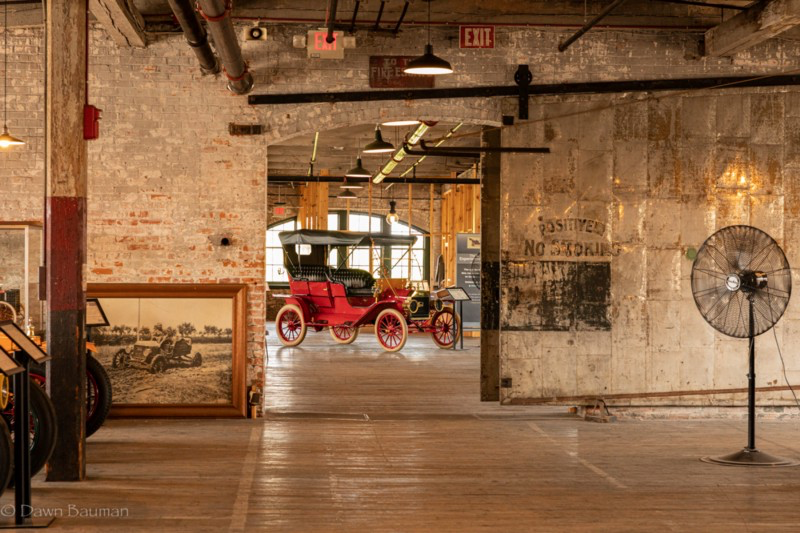
Ford introduced the model T in 1908 — and it went viral.
Over 15 1000000 sold.
Henry Ford had produced a great motorcar cheap enough for the mutual human being.
And it was all done at the Ford Piquette Avenue found.
Can't get plenty of those T's.
The Museum has a number of Model T'due south in their drove. The parent company owning the edifice and operating the museum is the Model-T Automotive Heritage Company, subsequently all.
On the first floor sits one of the oldest T's yet effectually — a carmine Model T (Serial #220). This car is "highly original" — with a known history. Because of that, information technology's used as the "standard" when comparing Model T's.
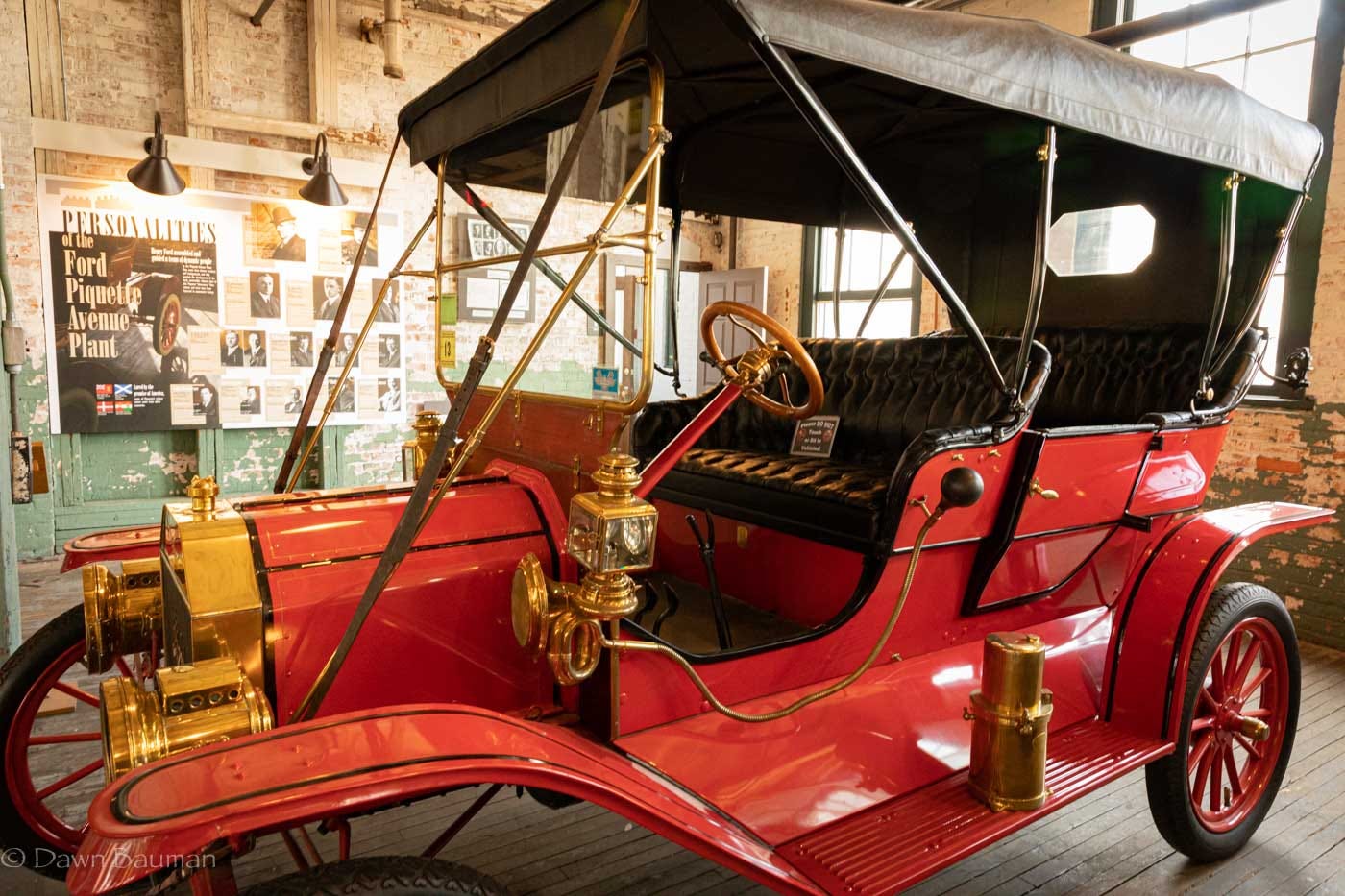
On the 3rd floor are T's that were modified into flower trucks, produce trucks, station wagons, dump trucks, tractors, and snowmobiles.
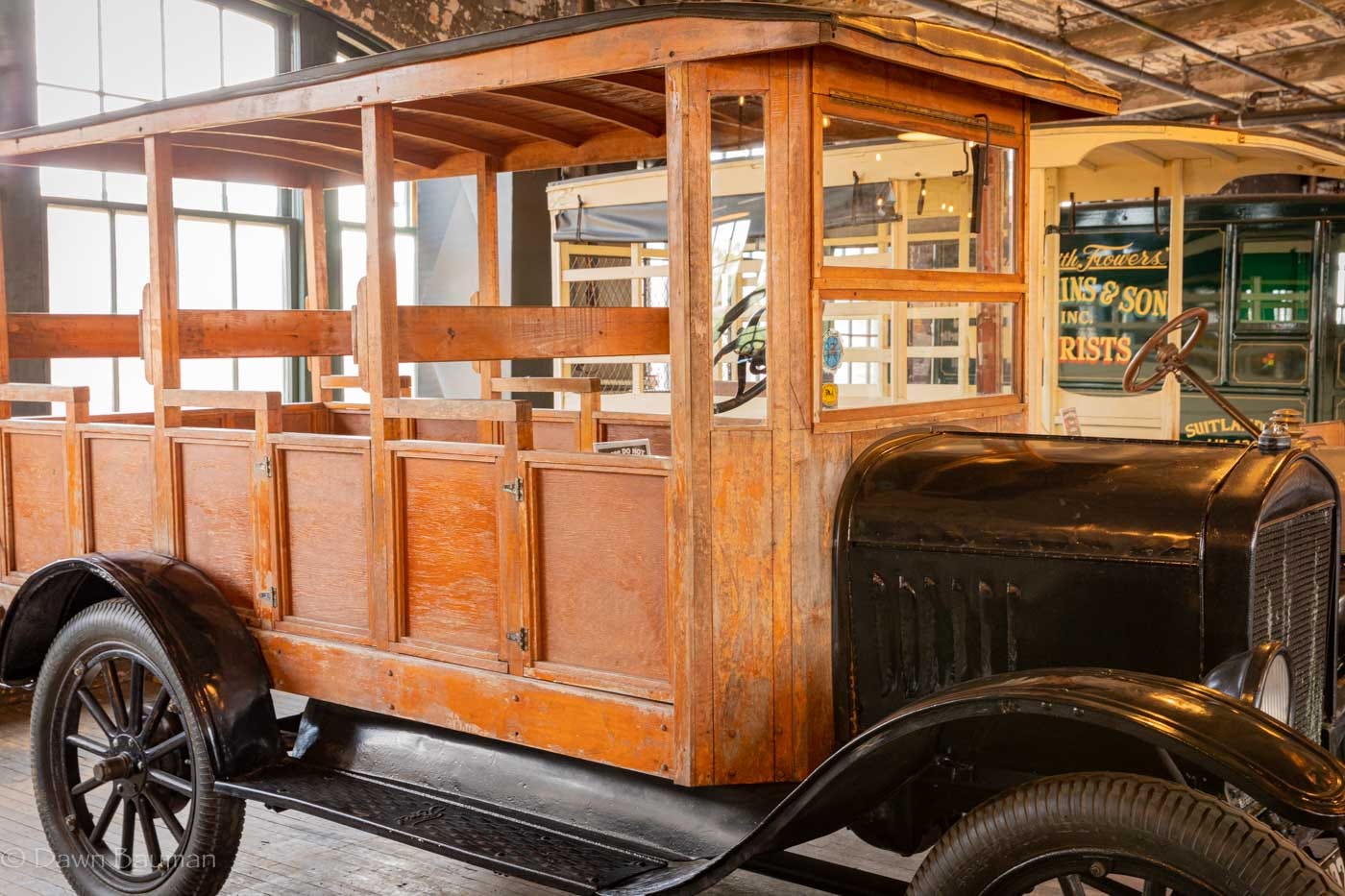
While you tin can't impact most of the cars, in that location is a 1915 Model T, "The Photo Car," that you can climb in, ham it upwards, and have your picture taken.
The "Motion picture Star Motorcar," another red Model T (Series #5375), was gifted to the museum after being used in numerous movies and press shots. Kids (of all ages) are immune to honk the horn at the end of the tour.
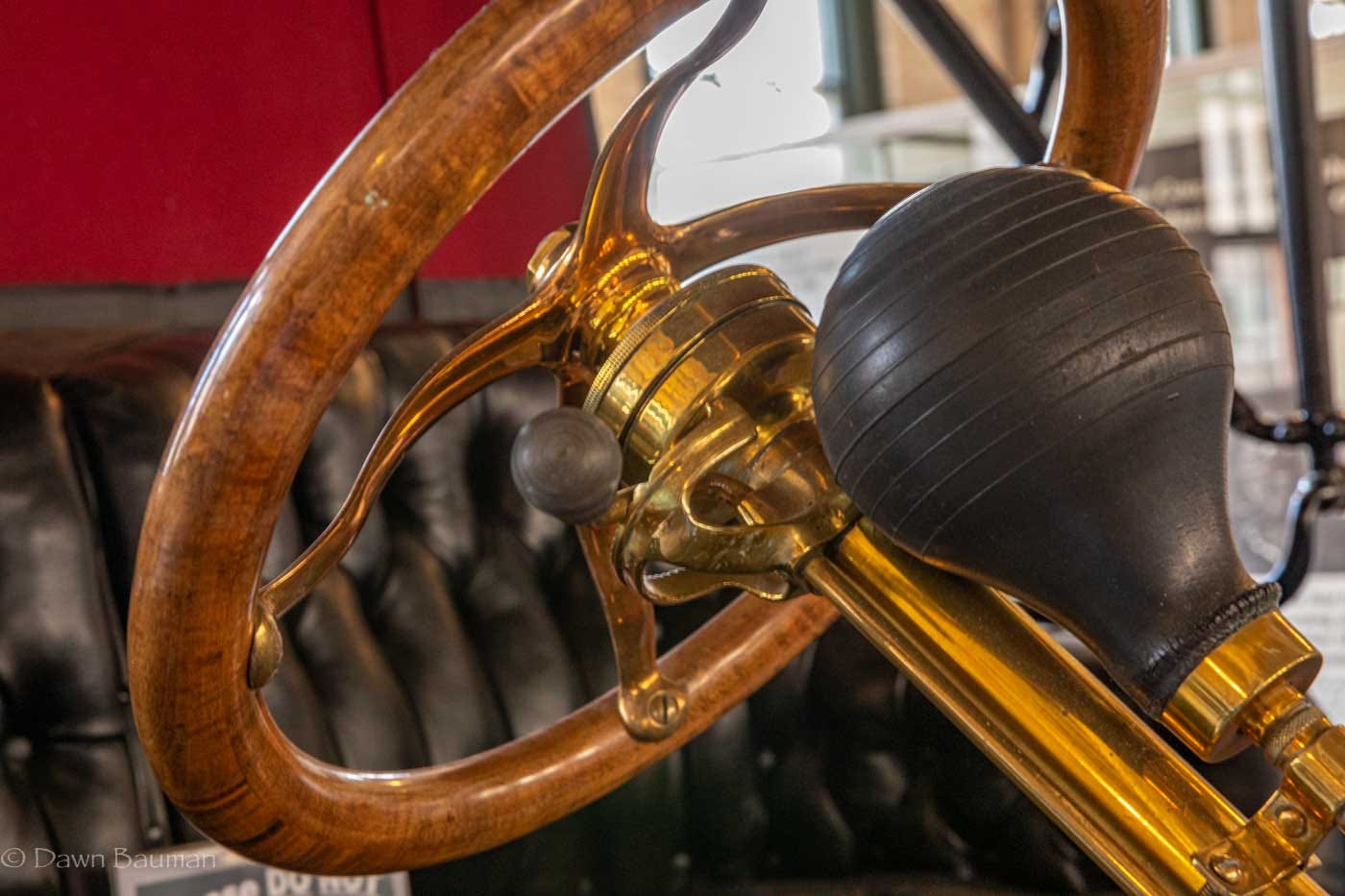
If yous like old cars, old buildings, and old stories — this museum is for you lot.
How much does information technology toll to go to the Ford Piquette Avenue Museum?
$12 for Adults (xiii+); $x for Seniors 65+; $5 for students (with ID); 12 and nether are Gratuitous. If you tin gather x or more people for a group tour, it's $8 a head.
Where do you park for the Ford Piquette Artery Museum?
In that location is free parking both side by side to and across from the museum.
Detroit'due south Wayne State Mortuary Science Museum — The One That Wouldn't Let Me In
I actually desire to see the Wayne State Mortuary Science Museum. I know information technology might seem gruesome, only, hey, I worked in an emergency room.
Unfortunately I found out nearly this museum likewise tardily, the bout was full, and I was leaving boondocks. So…it'due south on top on my list for the adjacent time I visit Detroit.
Who cares about the expressionless?
Apparently, since 1939, Wayne State University has been teaching students how to respectfully care for the dead in their Mortuary Science programme.
And, over the years, graduates of said programme donated items to the Academy that they had either found in their own funeral homes or ones they had personally collected.
Eventually, all these items relating to death and dying were organized — and a museum was built-in.
The early bird gets a tour.
I read well-nigh the museum in Secret Detroit: A Guide to the Weird, Wonderful, and Obscure by Karen Dybis.
It sounds fascinating which is probably why the tour sold out speedily — and why they had a "look list."
The tour takes you through the Mortuary Science building also equally the museum. The museum itself is only a classroom but according to Surreptitious Detroit: A Guide to the Weird, Wonderful, and Obscure:
"At that place is a bevy of caskets, embalming tools, medicine numberless, religious iconograpy and other materials used in the preparation of the body for burial. There are portable embalming kits, which funeral directors of old carried with them as they traveled to clients' homes to prepare the dead for burial…"
Mayhap it's just morbid marvel, but I'g intrigued about the ins and outs of Detroit'southward mortuary scientific discipline and death rituals. Hopefully, someday I'll get in.
vi Must-Run into Detroit Museums — Where The Past Lives On
So, there you have information technology. 6 unique museums effectually the downtown Detroit area.
All worth spending a few hours and a few bucks exploring.
All family and child-friendly (well, except perhaps that Mortuary Science one). All safe. And all with skilful parking.
From the early on days as a frontier boondocks to modern twenty-four hours urban renewal, visiting any of these museums will get out you lot with new insight into the Motor Urban center — a dynamic and e'er-changing metropolis.
So grab your kids — heck, grab your neighbour's kids too — and check'em out.
Source: https://medium.com/@Rdy2Trvl/detroit-5-must-see-museums-plus-1-that-wouldnt-let-me-in-66d0f7136abe